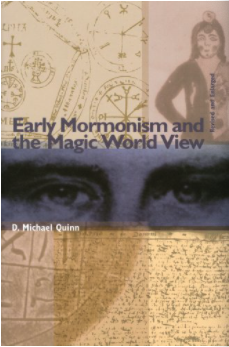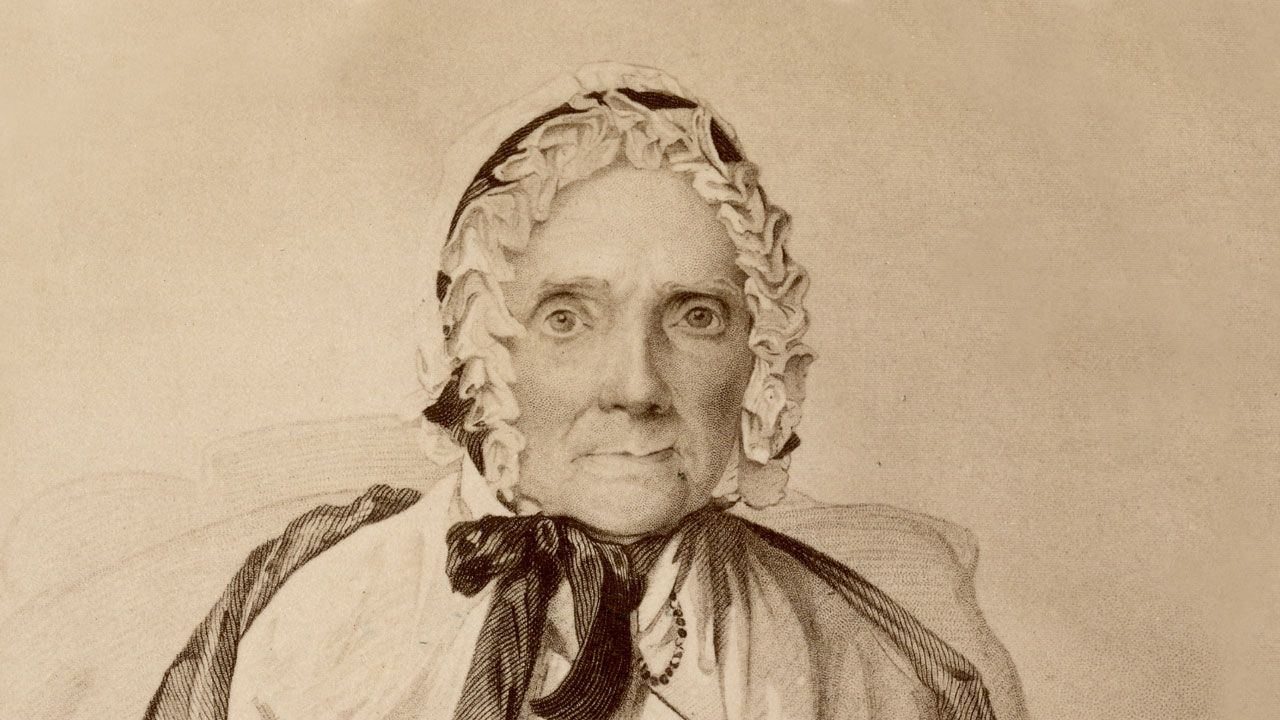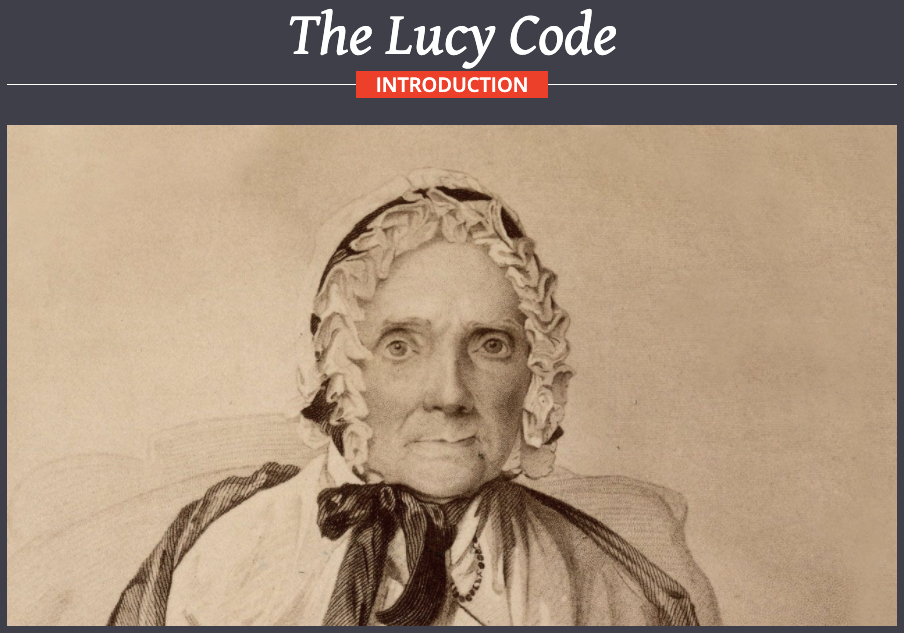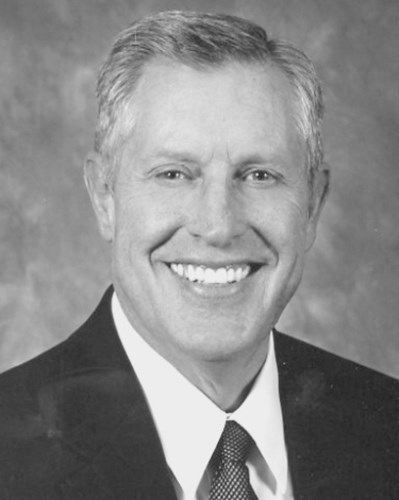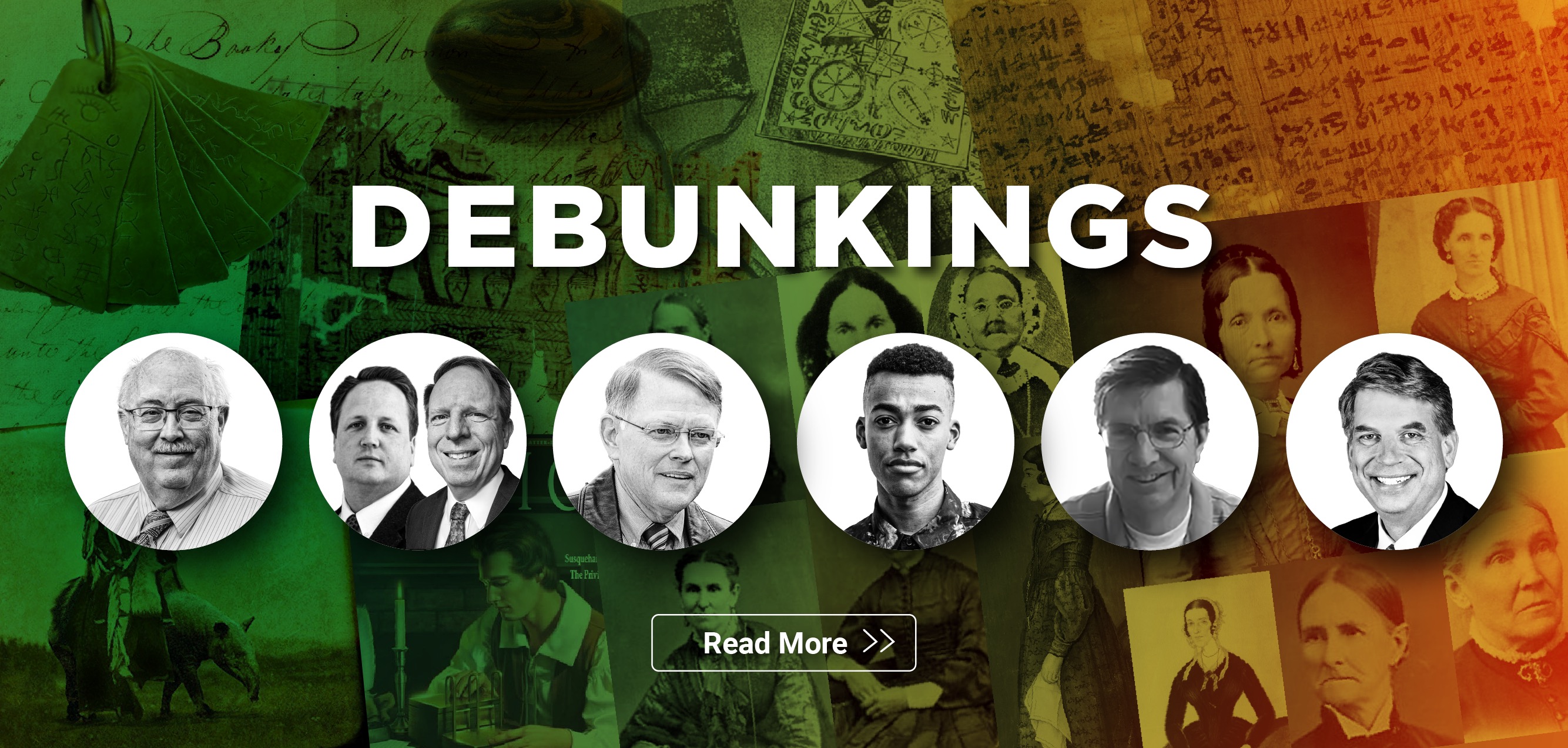Detailed Response
BOM Translation
Richard Bushman Quotes
“I will begin by saying that we still have pictures on our Ward bulletin boards of Joseph Smith with the Gold Plates in front of him. That has become an irksome point and I think it is something the church should pay attention to. Because anyone who studies the history knows that is not what happened. There is no church historian who says that is what happened and yet it is being propagated by the church and it feeds into the notion that the church is trying to cover up embarrassing episodes and is sort of prettifying its own history.
So, I think we ought to just stop that immediately. I am not sure we need a lot of pictures in our chapels of Joseph looking into his hat, but we certainly should tell our children that is how it worked... It’s weird. It’s a weird picture. It implies it’s like darkening a room when we show slides. It implies that there is an image appearing in that stone and the light would make it more difficult to see that image. So, that implies a translation that’s a reading and so gives us a little clue about the whole translation process. It also raises the strange question, ‘What in the world are the plates for? Why do we need them on the table if they are just wrapped up into a cloth while he looks into a seer stone?’”
– RICHARD BUSHMAN, LDS SCHOLAR, HISTORIAN, PATRIARCH
FAIRMORMON PODCAST, EPISODE 3: RICHARD L. BUSHMAN P.1, 47:251
”People say that the Book of Mormon certainly is an inspired and inspiring book, but the backstory of the plates in the translation is irrelevant to it. What would we gain and lose [if we abandoned the plates]? What we would lose would be a powerful form of evidence that the Lord gave to Joseph Smith and to us of the actuality of all these experiences, and therefore the actuality of the transcendent sphere... That would be gutting some of the most gritty and appealing parts of the Mormon story.”
– RICHARD BUSHMAN, LDS SCHOLAR, HISTORIAN, PATRIARCH, “THE GOLD PLATES IN MORMON CULTURE AND THOUGHT,” 41:47
Jeremy's Response
LDS scholar and historian, Richard Bushman, in a December 31, 2020 Salt Lake Tribune interview (Red emphasis added):
Have you changed your mind over the years about any of the church’s founding events?
In terms of the particulars — the overall story about the First Vision, gold plates, translation and a set of revelations to form a church — my view remains pretty much the way it was. But I do think about some things differently.
The Book of Mormon is a problem right now. It’s so baffling to so many that Joseph was not even looking at the gold plates [to translate them]. And there’s so much in the Book of Mormon that comes out of the 19th century that there’s a question of whether or not the text is an exact transcription of Nephi’s and Mormon’s words, or if it has been reshaped by inspiration to be more suitable for us, a kind of an expansion or elucidation of the Nephite record for our times. I have no idea how that might have worked or whether that’s true. But there are just too many scholars now, faithful church scholars, who find 19th-century material in that text. That remains a little bit of a mystery, just how it came to be.
In a private June 12, 2016 fireside, Mr. Bushman concedes that "the dominant narrative is not true; it can't be sustained.":
Rebuttal to Jim's "Short Answer"
Unlike the story I've been taught in Sunday School, Priesthood, General Conferences, Seminary, EFY, Ensigns, Church history tour, Missionary Training Center, and BYU...Joseph Smith used a rock in a hat for translating the Book of Mormon.
Ah, yes. The rock in a hat.
SHORT ANSWER:
The Book of Mormon is a bonafide miracle with unmistakable marks of antiquity that could not have been produced by anyone living in 1830. No other explanation other than the one offered by Joseph Smith can account for its existence.
You do not make it disappear by simply repeating a mantra about a rock in a hat.
Jeremy's Response
Stop the press! A person born into a Mormon Royalty family (Jim's grandfathers on both sides were Church presidents) and who was indoctrinated from birth in Mormonism has something shocking to announce to us all!
Jim Bennett: "The Book of Mormon is a bonafide miracle! No other explanation other than one given by Joseph Smith!"

Let's unpack and respond to each individual claim Jim makes:
"...unmistakable marks of antiquity..."
"...unmistakable marks of antiquity..."
Jeremy's Response
What's the opposite of antiquity and which would single-handedly debunk a claim of antiquity? Anachronisms.
Just on anachronisms alone is sufficient enough to debunk any claim that something is ancient or contains "marks of antiquity".
Oh, look...here's Jim himself admitting the Book of Mormon contains anachronisms:
Book of Mormon Anachronisms
If I were to show you this picture of Abraham Lincoln and claim that it's an untouched and accurate historical picture, would you believe me?
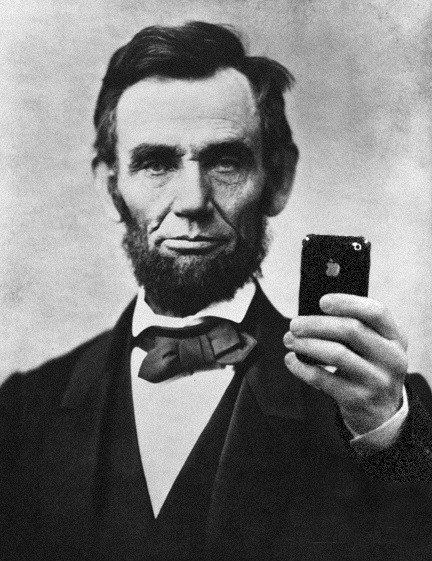
If you're a rational and sane person, you would clearly see that the above picture is fake. Why? Because it's an anachronism. It has an iPhone in Lincoln's hand that did not exist in the 1860s. I could offer you all kinds of gold medal gymnastic apologetics in the world trying to make this picture authentic and true and all you'd do is laugh at me. I could take a position like Jim does and try to tell you that this will become less anachronistic over time and you'd start to wonder about my mental health.
This is how scholars and academics who are experts in their specific fields look at the Book of Mormon and it's people like Jim who are trying to tell them that they need to take the picture (aka Book of Mormon) seriously while offering asinine apologetics that they think are "evidences" in attempts to legitimize the work.
In the Testimony & Spiritual Witness section, Jim shared a video about Hebraisms to support, in his mind, the truthfulness and antiquity of the Book of Mormon.
What Jim doesn't tell you is that, for example, 19th-century Late War also has Hebraisms in the book and this in turn is one of many things about that book that discredits the Book of Mormon. This article goes into more details on the weaknesses of Hebraisms being used to defend the Book of Mormon. Many of these "remarkable" Hebraisms appear to be natural human literary forms and can be found just about anywhere you look for them, including in Solomon Spaulding’s Manuscript Found, James Strang’s Book of the Law of the Lord, and other Bible-inspired 19th-century pseudepigrapha.
Oh, since we're on pseudepigrapha:
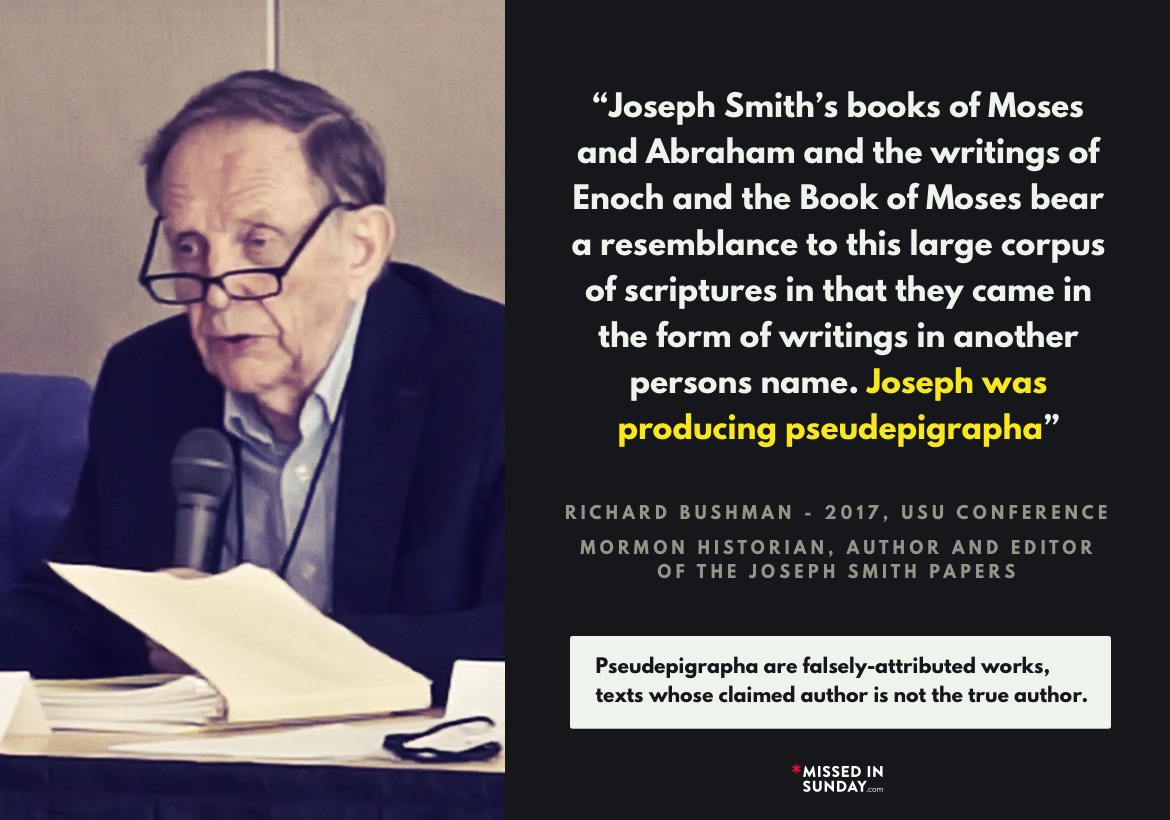
Click graphic for more info and video
Similar to Hebraisms, Mormon apologists love to point to chiasmus as evidence for the Book of Mormon as well. Well, you can find chiasmus in Dr. Seuss' book Green Eggs and Ham too.
It's just embarrassing that Jim is pointing to Hebraisms as evidence to support the antiquity and truthfulness of the Book of Mormon. Even Jim's fellow FairMormon apologist buddies are cringing here:
"The Book of Mormon does indeed have authentic Semitic constructions in it, but LDS need to tread cautiously in establishing them. Each must be evaluated on its own merits. Hebraisms that could have been known to Joseph Smith may still be authentic, and may still enhance our appreciation of the text, but they are weaker evidence for Book of Mormon antiquity since Joseph could have gotten them from his contemporary environment."
- FAIR, Hebraisms in the Book of Mormon
Even LDS scholar and historian Richard Bushman (and others as he mentions below) cringe at Jim's statement and claim that the Book of Mormon isn't a 19th-century document. Again, quoting Bushman from the above-mentioned Salt Lake Tribune article:
The Book of Mormon is a problem right now. It’s so baffling to so many that Joseph was not even looking at the gold plates [to translate them]. And there’s so much in the Book of Mormon that comes out of the 19th century that there’s a question of whether or not the text is an exact transcription of Nephi’s and Mormon’s words, or if it has been reshaped by inspiration to be more suitable for us, a kind of an expansion or elucidation of the Nephite record for our times. I have no idea how that might have worked or whether that’s true. But there are just too many scholars now, faithful church scholars, who find 19th-century material in that text. That remains a little bit of a mystery, just how it came to be.
"No other explanation for Book of Mormon"
"No other explanation other than the one offered by Joseph Smith can account for its existence."
Jeremy's Response

I'm gonna leave this right here...
(Click graphic)
The secular hypothesis I point to is infinitely more plausible, verifiable, demonstrable, rational, coherent and credible than your supernatural one of a resurrected Native American angel, gold plates, non-existent "Reformed Egyptian" and an ignorant farm boy with his folk magic treasure-digging rock and hat.
"Mantra" Strawman
"You do not make it disappear by simply repeating a mantra about a rock in a hat."
Jeremy's Response

Another strawman and misrepresentation from Jim. Not only does Jim misunderstand and misrepresent my arguments and concerns, he's attempting to reduce them to a fake "mantra" that I supposedly "repeat" to supposedly make the Book of Mormon "disappear".
You just don't get the core problem of the rock-in-the-hat, Jim. You said so yourself several times in your Jim Bennett Mormonism® Manifesto that you don't understand the problem with it.
So, it makes perfect sense in light of your ignorance of the core problem of the rock-in-the-hat that you've created a strawman and misrepresentation while attempting to reduce my concerns as a "mantra" that I bizarrely supposedly use to make the Book of Mormon "disappear".
Debunking Jim's misleading "Long Answer" claims
LONG ANSWER:
In my experience, the translation process wasn’t really discussed all that often, if at all. There was some discussion about the Urim and Thummim, which were, in fact, used during the translation, although it’s true that the rock in the hat never came up. That’s may be in part because it’s weird, and the Church doesn’t like to talk about weird things that might seem embarrassing. At the same time, I’m not sure why a rock in a hat is any weirder than granny glasses attached to a metal breastplate, which is how I’ve always envisioned it. I guess it all comes down to expectations.
The first time I heard the rock-in-the hat story was on my mission, when Joseph Fielding McConkie, son of Bruce R. and grandson of Joseph Fielding Smith, quoted David Whitmer on the subject and claimed that Whitmer didn’t know what he was talking about. Whitmer’s account about the process came decades later, after Joseph Smith’s death, and J.F. McConkie, taking a position he attributed to his father and grandfather, insisted it couldn’t have been that way, because reading words off a seer stone seemingly contradicts D&C 9, which is the only contemporaneous document on the subject that we have. D&C 9 chastises Oliver Cowdery for his translation attempt because he “took no thought save it was to ask” the Lord rather than trying to “study it out in [his] mind.”
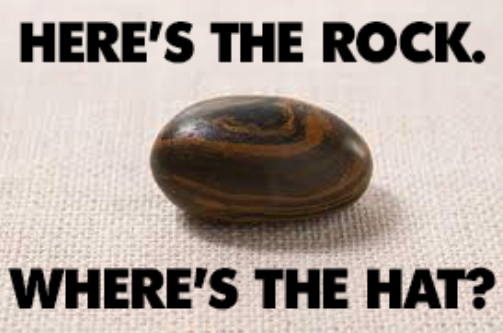
So if the rock in the hat idea wasn’t widely disseminated, which it wasn’t, it may have been because there was significant disagreement among the Brethren as to its veracity, with President Smith and Elder McConkie on the side that (probably incorrectly) maintained it was nonsense. The Church is now discussing the rock in the at and has even published pictures of the rock - but, curiously, not the hat.
So where’s the hat? What are they hiding from us?!
It’s worth mentioning that Whitmer was not, in fact, part of the translation process, and it may well be that he was incorrect, as his statements come way, way after the fact when he was disaffected from the Church. Of course, that would force you to consider the possibility of the Church being wrong now in admitting to the rock in the hat as opposed to being wrong then when they tried not to mention it. And in your black-and-white, irreducible theological expectations, the Church is never allowed to be wrong.
Joseph Smith himself dodged questions about specifics of the translation process, saying only that it was accomplished “by the gift and power of God” and that it “was not intended to tell the world all the particulars of the coming forth of the Book of Mormon.” So it seems the uncomfortableness about talking about the process goes way back to the beginning.
Jeremy's Response
Alright, let's unpack this and debunk each claim/attack individually:
"Urim and Thummim was, in fact, used during translation"
"There was some discussion about the Urim and Thummim, which were, in fact, used during the translation"
Jeremy's Response
What Jim isn't telling you here is which translation the Urim and Thummim were "used" for. They were "used" for the first 116 pages that were lost by Martin Harris. They were not used for the subsequent and separate Book of Mormon translation after the 116 pages. The lost 116 pages are not part of the Book of Mormon we have today.
It is the subsequent and separate translation after the lost 116 pages that produced the Book of Mormon we have today.

The Book of Mormon we have today was not translated with the Urim and Thummim. It was translated with Joseph's pagan, non-Moroni, folk magic found-in-my-neighbor's-well-in-1822-while-treasure-digging-and-the-tool-I-used-to-defraud-my-customers-with brown colored rock.
Jim's understanding here is just wrong. He's wrong about the Urim and Thummim and he's wrong that the Book of Mormon we have today was translated by anything other than Joseph's occult magic brown rock that he found in his neighbor's well a year before Moroni even showed up.
Even FAIR is telling the truth here:
Question: Why would Joseph Smith not continue to use the sacred interpreters provided with the Nephite record?
Ultimately, it was more convenient for him to use the seer stone [brown stone as shown in pictures given by LDS Church].
FAIR, Joseph Smith used the same "rock in hat" seer stone for translating that he used for "money digging"
Latter-day Saints associate the term "Urim and Thummim" with these interpreters. Gardner notes,
"We all know that Joseph used the Urim and Thummim to translate the Book of Mormon—except he didn't. The Book of Mormon mentions interpreters, but not the Urim and Thummim. It was the Book of Mormon interpreters which were given to Joseph with the plates. When Moroni took back the interpreters after the loss of the 116 manuscript pages, Joseph completed the translation with one of his seer stones. Until after the translation of the Book of Mormon, the Urim and Thummim belonged to the Bible and the Bible only. [51] The Urim and Thummim became part of the story when it was presented within and to the Great Tradition. Eventually, even Joseph Smith used Urim and Thummim indiscriminately as labels generically representing either the Book of Mormon interpreters or the seer stone used during translation."
After the loss of the 116 pages, contemporary accounts are very clear that Joseph continued the translation using his seer stone. In later years, the term "Urim and Thummim" was retroactively applied to both the Nephite interpreters and to Joseph's seer stone. Thus the use of "Urim and Thummim" tends to obscure the fact that two different instruments were employed.
FAIR, Joseph Smith used the same "rock in hat" seer stone for translating that he used for "money digging"
The problem here is that Jim is misunderstanding not just the narrative but the core problem of the rock-in-the-hat problem.
No Urim and Thummim were used for the Book of Mormon we have today. No Nephite Interpreters were used for the Book of Mormon we have today.
It was just the pagan, occult, pre-Moroni brown rock that Joseph found in his neighbor's well a year before Moroni even showed up and the same occult/folk magic tool and method that Joseph used in his fraudulent treasure-digging activities to defraud his customers out of their money.
Rock/Hat not "weirder than granny glasses on breastplate"
"...although it’s true that the rock in the hat never came up. That’s may be in part because it’s weird, and the Church doesn’t like to talk about weird things that might seem embarrassing. At the same time, I’m not sure why a rock in a hat is any weirder than granny glasses attached to a metal breastplate, which is how I’ve always envisioned it. I guess it all comes down to expectations."
Jeremy's Response
It's not about expectations, Jim. It's about your ignorance on the subject. You think the Church concealed and hid the rock-in-the-hat because it was "weird" and "embarrassing". Yes, it's both of those things but what you're missing here is that it's way worse than that.
The Church knew for decades that no plates and no Urim and Thummim were used for the translation of the Book of Mormon we have today. This is damning and it messes up so many things about the Church's founding narrative and story of its origins and the origins of the Book of Mormon.
The fact that Jim is so hung up on which device is "weirder" and thinking that's my primary issue or the fundamental problem here demonstrates Jim's astounding ignorance on the real core problem of the rock-in-the-hat translation.
It's not about expectations, Jim. It's about honesty. It's about the truth. It's about what the opening of the folk magic Pandora's Box reveals about Mormonism's founding. It's about this bizarre folk magic narrative ruining the Church's centuries' old carefully crafted founding narrative and truth claims.
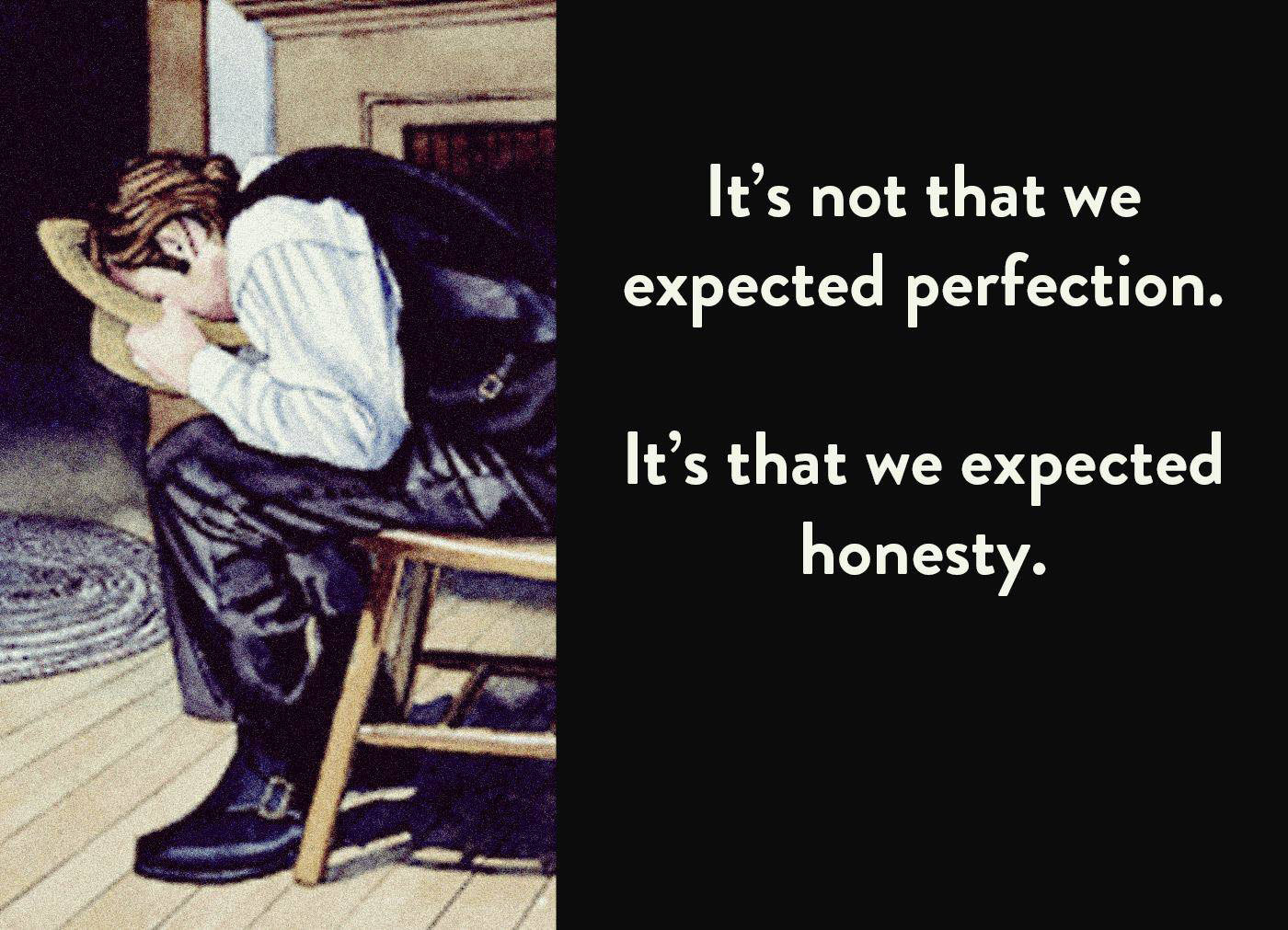
Jim keeps talking about "expectations" and how my "expectations" about the Church were wrong. This is a Jim Bennett Mormonism® attack as what he's really saying is that I followed the program too closely and I should've cooked up my own homemade Mormonism and ventured off the path to engage with Mormonism in a different way. Elsewhere in the Conclusion section, Jim makes a scary claim regarding expectations:
"What you are saying here is that when your long-unchallenged expectations encountered challenges, you questioned the Church rather than questioning your own expectations. It never seems to occur to you that your expectations might be the problem, not the facts."
My response:

This is how cult members think and talk. This is very dangerous thinking that keeps people trapped in cults. 2018 Jim's terrifying statement here says more about him and his mental cage than anything else.
Let's show how this looks with other cults saying the same thing:
Scientology:
"What you are saying here is that when your long-unchallenged expectations encountered challenges, you questioned the Church rather than questioning your own expectations. It never seems to occur to you that your expectations might be the problem, not the facts."
FLDS:
"What you are saying here is that when your long-unchallenged expectations encountered challenges, you questioned the Church rather than questioning your own expectations. It never seems to occur to you that your expectations might be the problem, not the facts."
Moonies:
"What you are saying here is that when your long-unchallenged expectations encountered challenges, you questioned the Church rather than questioning your own expectations. It never seems to occur to you that your expectations might be the problem, not the facts."
Jehovah's Witnesses:
"What you are saying here is that when your long-unchallenged expectations encountered challenges, you questioned the Church rather than questioning your own expectations. It never seems to occur to you that your expectations might be the problem, not the facts."
Branch Davidians:
"What you are saying here is that when your long-unchallenged expectations encountered challenges, you questioned the Church rather than questioning your own expectations. It never seems to occur to you that your expectations might be the problem, not the facts."
NXIVM:
"What you are saying here is that when your long-unchallenged expectations encountered challenges, you questioned the Church rather than questioning your own expectations. It never seems to occur to you that your expectations might be the problem, not the facts."
Heaven's Gate:
"What you are saying here is that when your long-unchallenged expectations encountered challenges, you questioned the Church rather than questioning your own expectations. It never seems to occur to you that your expectations might be the problem, not the facts."
Jim learned rock/hat from Mission Prez McConkie
Jim's statement about first learning the rock-in-the-hat on his mission by Joseph Fielding McConkie and being misled (albeit unintentionally) by the McConkies on this subject, etc.
Jeremy's Response
Jim spent ~19 years in Mormonism before learning about the rock-in-the-hat from his apostle's son mission president, Joseph Fielding McConkie, and Jim believed it was a lie / false claim until his late 40s when he read the Church's essay in recent years and accepted the fact - as shown in the above video.
"I felt like a chump"
Jim misleads & throws shade on BOM Witness David Whitmer
"It’s worth mentioning that Whitmer was not, in fact, part of the translation process, and it may well be that he was incorrect, as his statements come way, way after the fact when he was disaffected from the Church. Of course, that would force you to consider the possibility of the Church being wrong now in admitting to the rock in the hat as opposed to being wrong then when they tried not to mention it. And in your black-and-white, irreducible theological expectations, the Church is never allowed to be wrong.
Joseph Smith himself dodged questions about specifics of the translation process, saying only that it was accomplished 'by the gift and power of God' and that it 'was not intended to tell the world all the particulars of the coming forth of the Book of Mormon.' So it seems the uncomfortableness about talking about the process goes way back to the beginning."
Jeremy's Response
Let's unpack this:
Jim misleads his readers by his well-crafted words in stating that Whitmer was not part of the translation process. Well, duh. That's basically Primary 101. Everyone knows that and I never claimed that Whitmer was a scribe or that he took Joseph's place as translator.
What Jim doesn't share with us here though is what David Whitmer himself actually wrote and testified in his An Address to all Believers in Christ (that Jim curiously does not link to for his readers to read for themselves):

Source: An Address to all Believers in Christ, p.11
Wait, Book of Mormon witness David Whitmer says what?
"I testify to the world that I am an eye-witness to the translation of the greater part of the Book of Mormon. Part of it was translated in my father's house in Fayette, Seneca County, N.Y. Farther on I give a description of the manner in which the book was translated."
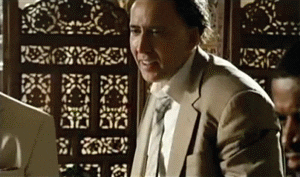
Funny how we didn't get these very pertinent pieces of information from Jim, huh?
I'm just gonna go ahead and borrow Jim's little bat he uses to unjustly beat me with all the time for a second here: Jim has not read the source and doesn't know what he's talking about. It is this bad information and poor/shoddy scholarship on Jim's part in his badly written Jim Bennett Mormonism® Manifesto that is misleading a lot of people and leading them astray.
Moving on, this is also Jim's Jim Bennett Mormonism® attempt to diminish and throw shade on Book of Mormon witness David Whitmer as unreliable because his testimony is written "after the fact".
"Apologists extend the broadest possible latitude to sources they agree with, yet impose the most stringent demands on sources of information the apologists dislike."
D. Michael Quinn
Early Mormonism and the Magic World View, p.47
Jim's shade and attack on Book of Mormon witness David Whitmer's "after the fact" testimony is a common problem with Mormon apologetics where they will accept any long-dated testimony that backs up their claims while dismissing sources that undermine their position as being "too late to count". Furthermore, as mentioned in the Book of Mormon Translation essay, the Church itself admits that Joseph Smith used the stone in a hat. They acknowledge this not just because of David Whitmer's testimony but because of Martin Harris' account as well, which was published in the Millennial Star - a Latter-day Saint newspaper that was printed in England from 1840 until 1970, when it was replaced by the Church's Ensign. Emma Smith also described the process this way.
Even though all three accounts are given later (an argument that Jim uses to try to invalidate Book of Mormon witness David Whitmer), all three later accounts are simply not in dispute among the majority of LDS or non-LDS historians and scholars, which is why the LDS Church conceded this as fact in its December 2013 Book of Mormon Translation essay...that thankfully, 2021 Jim has wisely changed his mind on and which fact he now accepts.
Jim also activates his Jim Bennett Mormonism® by trying to turn the translation process into a mystery that everyone was "uncomfortable" talking about. What Jim fails to account for here is that the Church did talk about how the Book of Mormon was translated - with gold plates, Urim and Thummim, breastplates with spectacles. They not only talked about this ad nauseum, they made sure to put it in the Missionary discussions to tell the world about. The problem was that the translation version / story they were peddling all along is fake and is not true. The Church knew this for decades while misleading members and the world on the translation.
Jim is trying to gaslight us here into thinking that the Church didn't know or couldn't come to a conclusion on how the Book of Mormon was translated and therefore its concealment is not nefarious or that the Church is off the hook for not disclosing the rock-in-the-hat to its members.
Russell M. Nelson's July 1993 A Treasured Testament article in the Ensign alone debunks this. There's obscure Church magazine articles from the 1970s (1977 Ensign and 1974 Friend) that FairMormon hilariously points to that talk about the rock. The Church has known this for decades and has concealed and hidden the rock-in-the-hat story from its members for generations. Full stop.
Here's what matters now: It's 2021 and the LDS Church now acknowledges that the Book of Mormon was translated with the brown stone in a hat. Jim acknowledges this. Jim acknowledges that the Church was not transparent about this for decades.
Jim Bennett Mormonism® attack on "Church never wrong"
"And in your black-and-white, irreducible theological expectations, the Church is never allowed to be wrong."
Jeremy's Response
Oh, look...another Jim Bennett Mormonism® attempt to denigrate me and gaslight us all on our lived Correlated Orthodox Chapel Mormonism experience and expectations in the Church.
Gee, I wonder where we all got the "black-and-white" idea that the Church is never wrong?
"I never told you I was perfect, but there is no errors in the revelations which I have taught..."
- The Words of Joseph Smith, ed. Andrew F. Ehat and Lyndon W. Cook [1980], 369.
"The Prophet will not lead you astray"
"We will not and cannot lead you astray"
"We will always teach the truth"
"They are the most perfect, inspired, unflawed leaders on Earth"
"When the Prophet speaks...Sisters, the debate is over"
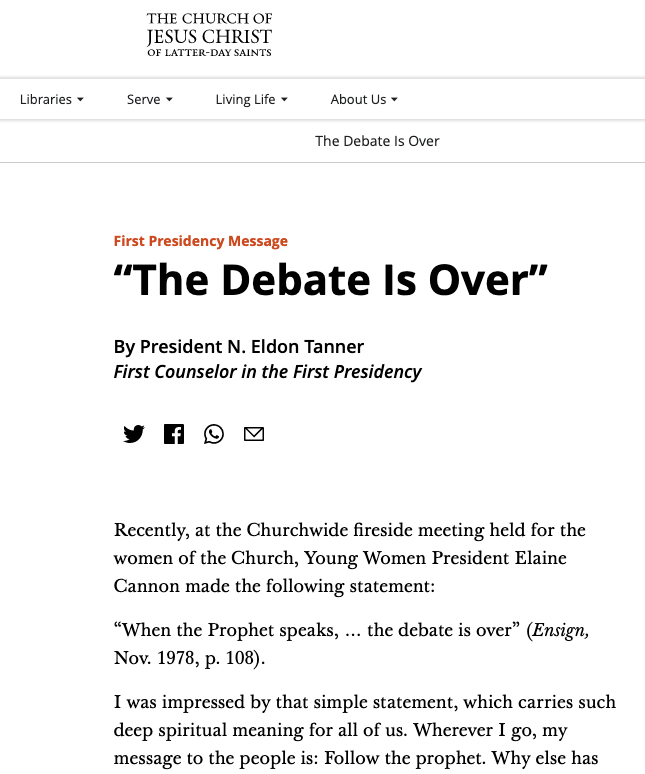

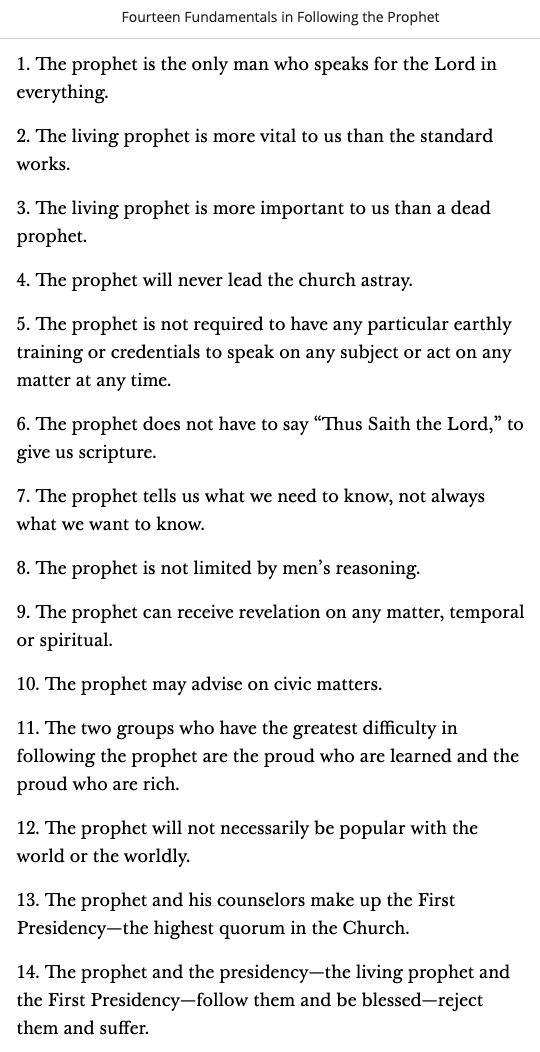
No gold plates for Book of Mormon translation
Having read through your letter multiple times, I think it’s safe to say that this is the one objection that you come back to more than any other. Variations of the phrase “rock in a hat” appear thirteen times throughout this version of your letter, and as you’re summing up the entirety of what you’ve written, you say the following:
At the end of the day? It all doesn’t matter. The Book of Mormon Witnesses and their testimonies of the gold plates are irrelevant. It does not matter whether eleven 19th century treasure diggers with magical worldviews saw some gold plates or not. It doesn’t matter because of this one simple fact:
JOSEPH DID NOT USE THE GOLD PLATES FOR TRANSLATING THE BOOK OF MORMON

In the first [2016] version I replied to, this was followed by one final graphical [above graphic] dig at the rock in the hat. (Wonder where that graphic went. Tone problems, I guess.)
The problem with this is that it seems to suggest that process somehow precludes product. I confess I find your obsession with this issue baffling. It’s undeniable that the Book of Mormon was produced in a manner you find strange or ridiculous. It’s also undeniable that the Book of Mormon is here; it exists, and it must be accounted for. Nowhere in your CES Letter do you provide any explanation for how that could be. Instead, you offer half a dozen contradictory theories about plagiarism that are demonstrably garbage, and you fixate on the rock in the hat, as if it makes it all 265,000 words vanish in a puff of smoke. It doesn’t, which is why millions of people still have testimonies of its truthfulness and divine origin.
Jeremy's Response
Let's unpack this and debunk individually:
Graphical Fake Scandal
In the first [2016] version I replied to, this was followed by one final graphical [above graphic] dig at the rock in the hat. (Wonder where that graphic went. Tone problems, I guess.)
Jeremy's Response
It went to the end of the Witnesses section of the CES Letter, Jim. Here's a screenshot:

It has nothing to do with "tOnE pRoBleMs" and everything to do with finding a better home for it (in the Witnesses section) along with adapting it to fit with the interior layout of the new paperback book.
This is just Jim baking a fake scandal to make me look petty.
This is a nothingburger. The graphic is still in the CES Letter. I just moved it to a more relevant place and converted it into words from its big graphic so that it fits in the new interior layout of the paperback book better.
Process & Product = Entwined
The problem with this is that it seems to suggest that process somehow precludes product.
Jeremy's Response
No. Nice strawman though.
The gold plates have nothing to do with the Book of Mormon we have today because it wasn't used in the "translation" process. It's irrelevant. In fact, it's so irrelevant that you're even seeing Jim and apologists like him desperately trying to save the plates by inventing other reasons for its existence such as being a laughable prop for the Witnesses; which has its own separate serious problems that we discuss in detail in the Witnesses section.
Here's what Jim seems to be avoiding: the narrative of the origins of the gold plates along with the origin of the Book of Mormon and how it came into existence is part of the end product. It's not just the process - it's the product too. Without this part of the product, the Book of Mormon is just a book with an ungodly amount of "and it came to pass" in it.
This is why we get statements of incredulity and dismay from BYU Professor Joseph Fielding McConkie and scholar Richard Bushman below in the next box answer.
The problem is that the process goes hand-in-hand with the product. If the process is messed up and contradicts the product, which the description of the process is entwined with, the product becomes even more defective and suspect.
This is partly why I keep trying to tell you why the rock in the hat is so damning and problematic: it screws with the product because it's presenting an entirely different process and that process is that of 19th-century folk magic and occultism which completely contradicts the original carefully crafted narrative that the Church indoctrinated its members with for generations.
That the product (Book of Mormon) came into existence by the same method and means that Joseph Smith used to defraud people out of their money with his treasure / money digging activities is highly problematic, to say the least.
"I don't understand the problem here"
I confess I find your obsession with this issue baffling. It’s undeniable that the Book of Mormon was produced in a manner you find strange or ridiculous.
[Jeremy's Note: Elsewhere, Jim says something similar which I'm including here:]
I also still don’t understand why this information is “disturbing.” There’s nothing morally or ethically problematic about a rock in a hat versus a pair of gray spectacles attached to a breastplate, and the only reason the second isn’t upsetting to you is that it’s what you expect, and the first isn’t. I would think, to someone with no knowledge of these events, that both scenarios would be equally weird. The picture in your first batch with Joseph using the Urim and Thummim looks stranger to me than any picture in the second batch.
And, again, none of this diminishes the reality of the Book of Mormon, its historicity, or its message.
Jeremy's Response
"yOuR oBsEsSiOn" lol. Okay, Jim.
The reason why I mention it throughout the CES Letter is because the rock in a hat is not contained in a vacuum. It's connected to other areas such as Joseph's involvement with treasure digging; the Book of Mormon origin narrative and claim (Moroni, gold plates, etc.); it's connected to the Book of Abraham and Kinderhook Plates as it's part of a translation; it's connected to Joseph's modus operandi in how he presented and tricked people of his prophetic abilities; it's connected to the Witnesses; it's connected to the LDS Church's lack of integrity and lack of transparency; and it's connected to the disturbing folk magic / occult birth and origins of the religion.
The problem here isn't my "oBsEsSiOn" or that I think it's strange or ridiculous (I'm not alone in this assessment). The problem is that you don't understand the core problem and threat of the rock in the hat. You even admit that you don't get it and you find it "baffling".
Like Mufasa or Ouija Board...you don't seem to be able to see beyond the surface and what lies beneath. You take things literally and at face value.
You find it baffling because you don't understand the threat that folk magic and occultism poses to the very foundations of Mormonism, its origins and its founding narratives.
It's not just a weirdness or transparency problem. It's a founding narrative problem. It's a product problem.
Your Mission President, Joseph Fielding McConkie, understood this:
Mission Prez vs. Jim
"Finally, [the rock-in-the-hat translation method] simply does not accord with the divine pattern. If Joseph Smith translated everything that is now in the Book of Mormon without using the gold plates, we are left to wonder why the plates were necessary in the first place. It will be remembered that possession of the plates placed the Smith family in considerable danger, causing them a host of difficulties. If the plates were not part of the translation process, this would not have been the case.
It also leaves us wondering why the Lord directed the writers of the Book of Mormon to make a duplicate record of the plates of Lehi. This provision which compensated for the loss of the 116 pages would have served no purpose either.
Further, we would be left to wonder why it was necessary for Moroni to instruct Joseph each year for four years before he was entrusted with the plates. We would also wonder why it was so important for Moroni to show the plates to the three witnesses, including David Whitmer. And why did the Lord have the Prophet show the plates to the eight witnesses? Why all this flap and fuss if the Prophet didn't really have the plates and if they were not used in the process of translation?
What David Whitmer [and my former missionary Jim Bennett] is asking us to believe is that the Lord had Moroni seal up the plates and the means by which they were to be translated hundreds of years before they would come into Joseph Smith's possession and then decided to have the Prophet use a seer stone found while digging a well so that none of these things would be necessary after all.
Is this, we would ask, really a credible explanation of the way the heavens operate?"
- Joseph Fielding McConkie,
The Process of Translating the Book of Mormon"
LDS scholar and historian Richard Bushman gets it:
"The Book of Mormon is a problem right now. It’s so baffling to so many that Joseph was not even looking at the gold plates [to translate them]. And there’s so much in the Book of Mormon that comes out of the 19th century that there’s a question of whether or not the text is an exact transcription of Nephi’s and Mormon’s words"
"the dominant narrative is not true; it can't be sustained."
"There’s nothing morally or ethically problematic about a rock in a hat versus a pair of gray spectacles attached to a breastplate, and the only reason the second isn’t upsetting to you is that it’s what you expect, and the first isn’t. I would think, to someone with no knowledge of these events, that both scenarios would be equally weird. The picture in your first batch with Joseph using the Urim and Thummim looks stranger to me than any picture in the second batch...And, again, none of this diminishes the reality of the Book of Mormon, its historicity, or its message."
Even further evidence that you just don't get it, Jim.
Your false equivalence of rock in a hat versus a pair of gray spectacles attached to a breastplate in the context of weirdness demonstrates that you do not understand this issue and do not understand the core problem and threat.
The gray spectacles attached to a breastplate? That came from God. It has a divine origin because, according to the narrative we all grew up on, God preserved the Urim and Thummim and Nephite Interpreters and gold plates for centuries underground for the purpose of giving Joseph Smith to translate into the Book of Mormon in the 19th-century.
The rock in the hat? It was just a rock that Joseph found in his neighbor's well before Moroni showed up. It has nothing to do with Moroni. It has nothing to do with God. It was not preserved like the above mentioned gear was. It was not withheld from Joseph until he completed his education with Moroni. It was just an occult rock or folk magic device that Joseph used to con people out of their money in the family's treasure digging con business.
Apples and oranges. Are you beginning to see how your comparison is a misleading false equivalence?
I'll try to make it simple by adding pictures:

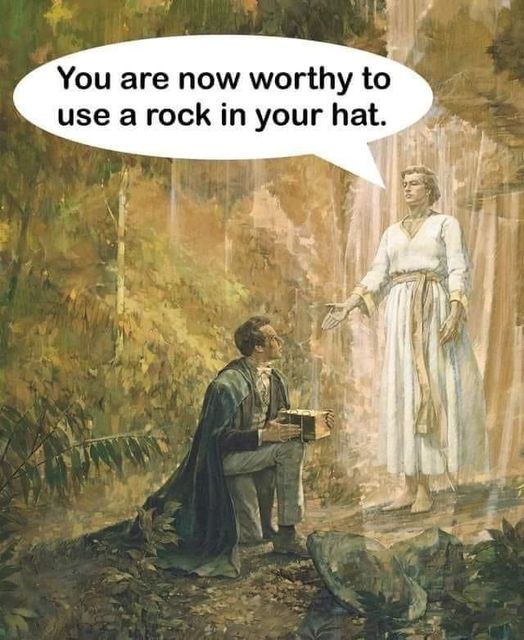
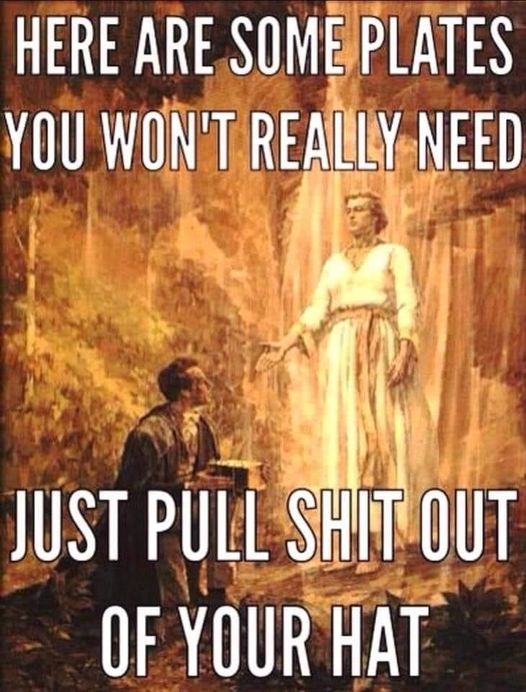
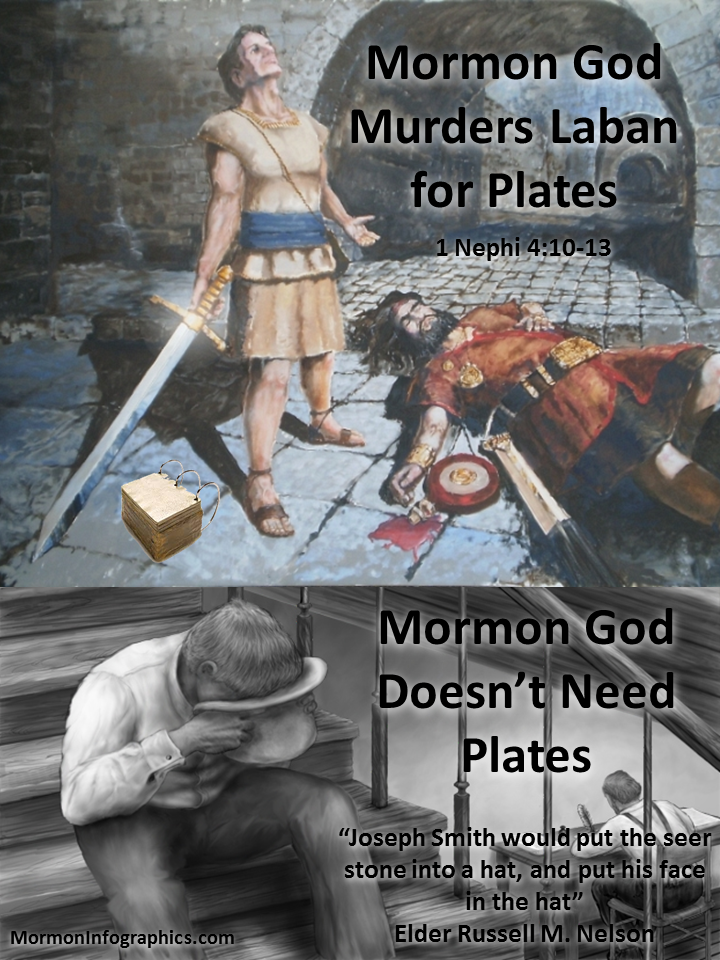


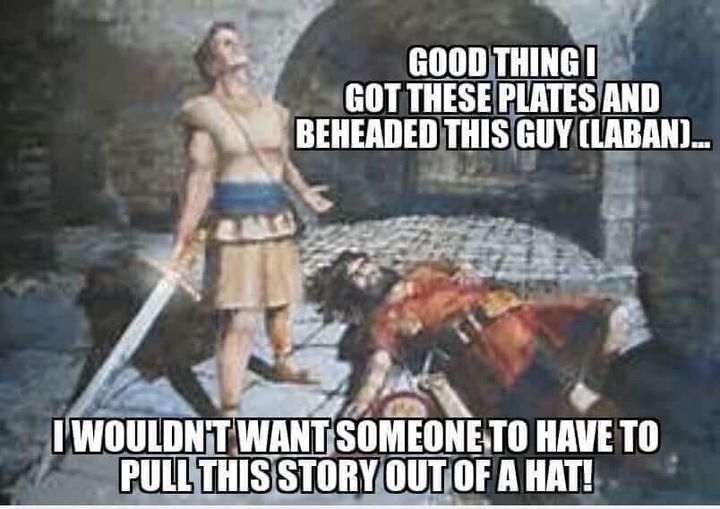
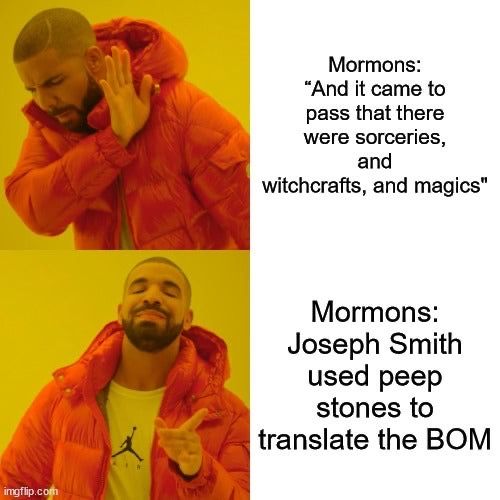
Book of Mormon is here. How?
It’s also undeniable that the Book of Mormon is here; it exists, and it must be accounted for. Nowhere in your CES Letter do you provide any explanation for how that could be.
Jeremy's Response
There's something called "burden of proof", Jim. Learn about it. You're the one here who is claiming the book is special and is of divine origins. You're making the supernatural claims here so the burden of proof is on you to prove your case; not on me. Having finished reading your entire diatribe with a fine-tooth comb? I can confidently state that you have not only not demonstrated your case but your attempts in doing so is just embarrassing.
The burden of proof
You act as if the book is so special that only supernatural phenomena can account for it. It's called "indoctrination". The only reason why you think it's super special is because you were programmed from birth to believe the book is super special.
But I like fun so I'll play along with this.
The core question here is: is the Book of Mormon ancient? Is it a factual and true history of real people and real places and real events? Is it historical?
Like a crime scene, we do not need a video recording or confessions from the suspect(s) or a witness statement to show whether or not the suspect(s) murdered with a gun. The body riddled with 9mm bullets and the presence of 9mm shell casings on the floor is sufficient evidence to establish the fact that the suspect(s) used a 9mm pistol in murdering the victim.
It's now only a question of the identity of the suspect(s), the motives, the means and the opportunity.
The bullets and shell casings in the crime scene of the Book of Mormon? Anachronisms. 19th-century fingerprints, signatures, themes and influences.
It wasn't my intent to go into conspiracy theories speculating how the book was specifically authored and manufactured and created. It wasn't my intent to get into the details of specific authors, specific motives, and the means and the opportunity. My intent is to show the anachronisms and 19th-century "bullets" and "shell casings" that demonstrate that the Book of Mormon is not what it or the LDS Church claims it to be: an ancient record.
I'm not alone in pointing out the anachronisms and 19th-century fingerprints in the Book of Mormon. Even Jim Bennett admits there's anachronisms in the Book of Mormon:
Book of Mormon Anachronisms
And even LDS historians and scholars are acknowledging the anachronisms and 19th-century fingerprints and signatures in the Book of Mormon:
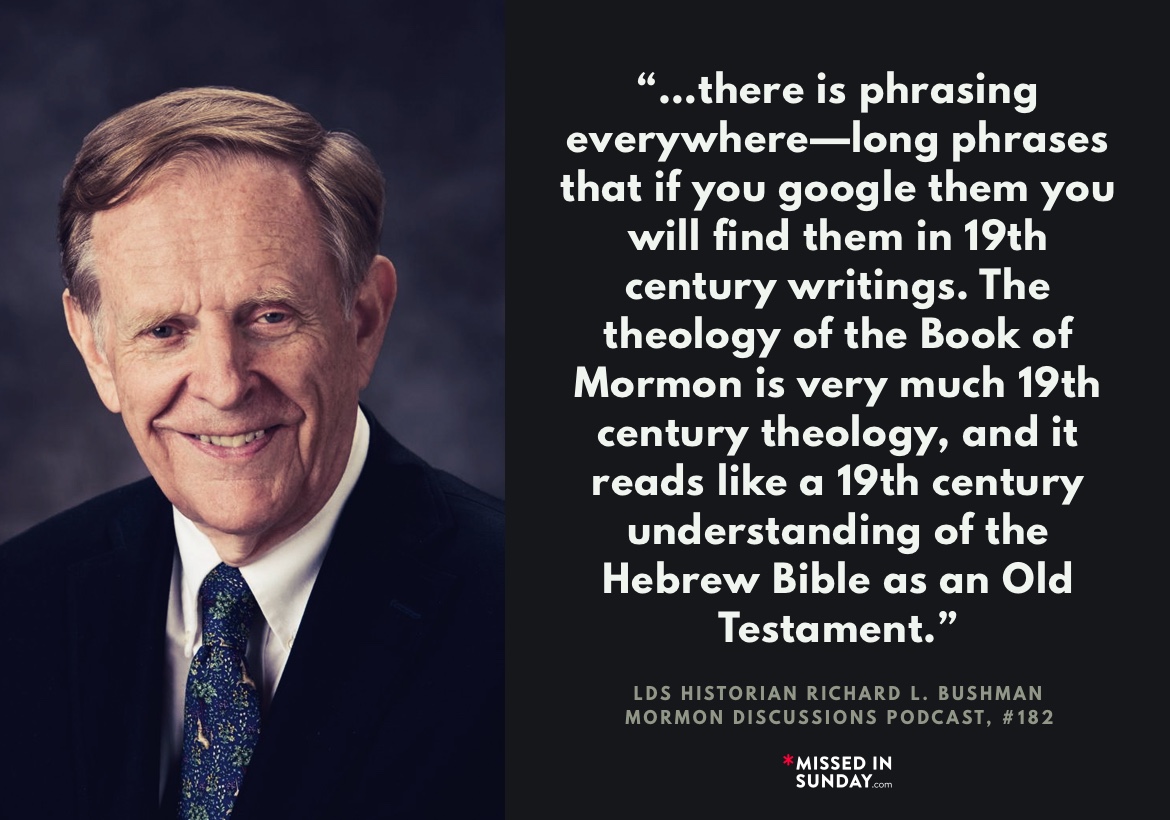
"The Book of Mormon is a problem right now. It’s so baffling to so many that Joseph was not even looking at the gold plates [to translate them]. And there’s so much in the Book of Mormon that comes out of the 19th century that there’s a question of whether or not the text is an exact transcription of Nephi’s and Mormon’s words, or if it has been reshaped by inspiration to be more suitable for us, a kind of an expansion or elucidation of the Nephite record for our times. I have no idea how that might have worked or whether that’s true. But there are just too many scholars now, faithful church scholars, who find 19th-century material in that text. That remains a little bit of a mystery, just how it came to be."
-Richard Bushman, December 31, 2020 Salt Lake Tribune interview
All I'm pointing to in the CES Letter is the milieu of influences documented in Joseph Smith's time and place that are similar to the Book of Mormon's language, phrasing, theology, themes and claims. I'm just pointing to the 19th-century bullets and shell casings. I'm pointing to the anachronisms.
"Joseph Smith was very eclectic. He drew upon ideas from all over, including Masonic ritual."
-Richard Bushman, LDS scholar, Reddit Ask Me Anything, 12/06/13
It is only now in 2021 that I offer here for the first time what I consider to be the most plausible and natural secular hypothesis (since we'll never know for sure as its conspirators are all dead) on the Book of Mormon's authorship and origin:
(Click graphic)
The secular hypothesis I point to is infinitely more plausible, verifiable, demonstrable, rational, coherent and credible than your supernatural one of a resurrected Native American angel, gold plates, non-existent "Reformed Egyptian" and an ignorant farm boy with his folk magic treasure-digging rock and hat.
Plagiarism strawman & Bandwagon fallacy
Instead, you offer half a dozen contradictory theories about plagiarism that are demonstrably garbage, and you fixate on the rock in the hat, as if it makes it all 265,000 words vanish in a puff of smoke. It doesn’t, which is why millions of people still have testimonies of its truthfulness and divine origin.
Jeremy's Response
No. You're not only misrepresenting my arguments but you clearly do not understand my positions.
My argument is not direct plagiarism. That's your strawman. I'm simply pointing to the milieu of 19th-century influences and sources that are very similar to the Book of Mormon's language, phrasing, theology, themes and claims.
As I've talked about in the last box answer, I'm simply pointing to anachronisms and 19th-century bullets and shell casings that demonstrate that the Book of Mormon is not an ancient document or a literal history of real peoples and real events.
Please see the above previous box answer for a more thorough debunking of Jim's attack here.
"cOnTrAdIcToRy tHeOrIeS" and "gArBaGe"
See the Book of Mormon section and judge for yourself who is actually peddling demonstrable garbage here.
"you fixate on the rock in the hat, as if it makes it all 265,000 words vanish in a puff of smoke."
Another strawman of Jim's. See my debunking of this strawman here.
"It doesn’t, which is why millions of people still have testimonies of its truthfulness and divine origin."
Nice little Bandwagon fallacy there, Jim.
Here's the cold, hard reality: On a global scale, the Mormon Church is a rounding error.
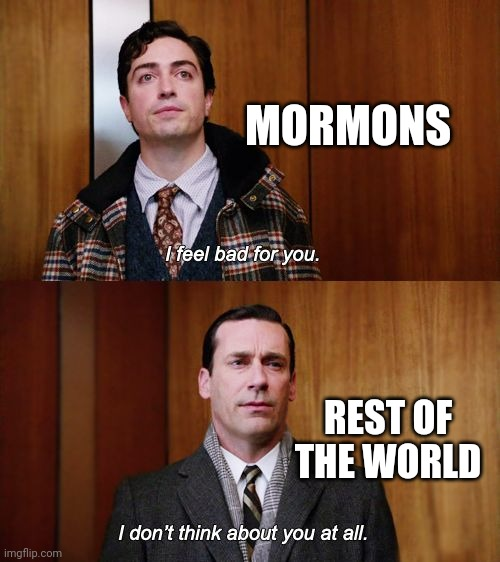
Assuming that there's actually 16 million members of the Church, this represents only a fraction of 1% of the world's population. But there aren't 16 million believing members of the Church. The general consensus among scholars and researchers is that there are around 4-6 million active believing Mormons. So, an even less percentage of the world's population.
Using Jim's flawed logic here, we should all be switching over to the Quran as it's infinitely more popular than the Book of Mormon.
I go over epistemology and the problems of Mormon epistemology in the Testimony & Spiritual Witness section.
Jim's Ouija Board Mischaracterization
In other words, Joseph used the same magic device or “Ouija Board” that he used during his treasure hunting days.
Those are other words, all right. They’re also wrong. Why do you put “Ouija Board” in quotes? Nobody but you is comparing this to a Ouija Board. Have you ever seen a Ouija Board?
They look like this:

Call me crazy, but that doesn’t look like a rock in a hat.
Jeremy's Response


I don't know what the problem is here. I mean, it's like Jim has trouble with non-literal language and can't understand the underlying message and points that I'm making with my non-literal statements. It's like he can't read between the lines. ¯\_(ツ)_/¯
I'm seeing Jim completely misunderstanding and missing my non-literal points and statements way too often in his Jim Bennett Mormonism® Manifesto. He's doing it here with the Ouija Board. He did it with my statement about Elder Andersen. He did it with my Lion King and Mufasa rhetorical questions.
So, I don't know. All I know is that it's so bizarre and annoying that Jim does this and keeps doing this blatant deceptive twisting of my non-literal statements and points as literal statements and points.
Anyway, my response:
Joseph Smith and his family were involved in what scholars D. Michael Quinn (Early Mormonism and the Magic Worldview) and Dan Vogel call "Christian magic" or "occult" (not Satanism but a heterodox form of Christianity in 19th-century rural New England and elsewhere) that practiced folk magic in the context of treasure hunting and glass-looking. Peep stones included.
An Ouija Board is a magic occult device that is "ostensibly used for obtaining messages from the spirit world".
A peep stone in a hat was a magic occult device that was used for obtaining messages from the spirit world.
The peep stone in the hat was the magic device or "Ouija Board" of Joseph's time and place that was used for fraudulent treasure digging activities where he would tell his customers where gold, silver, cattle, etc. were hidden or buried in exchange for money for his "services". It was a con family business.
It's a complete shock to the modern Mormon to all of a sudden learn about completely bizarre and strange 19th-century treasure digging, glass-looking, peep stones in hats, second sight, divining rods, magic worldview, etc.
My purpose in using the term "Ouija Board" is to help my modern readers understand that this was a folk magic occult device similar to Ouija Boards because the device claims to receive messages from the supernatural realm - just like the purpose of the rock in a hat device was for treasure hunting Joseph Smith and his family. Most modern readers understand what an Ouija Board is but are unfamiliar with rocks in hats. This is simply a comparison to bridge that gap. I am not claiming that Joseph Smith used an Ouija Board to translate the Book of Mormon despite Jim's and TITS' bizarre and dishonest attempts to smear me as claiming.
Further, it is not a snark or an attempt to denigrate on my part. It's a legitimate comparison as a peep stone in a hat and the Ouija Board are both occult devices that are used for the purpose of "receiving" messages from the spiritual / supernatural realm. Additionally, most members of both 19th-century and 21st-century societies look down on their respective occult devices as nonsense and irrational - with Joseph's own father-in-law, Isaac Hale, being an example of this skepticism and disdain for folk magic and occult devices in Joseph's time:
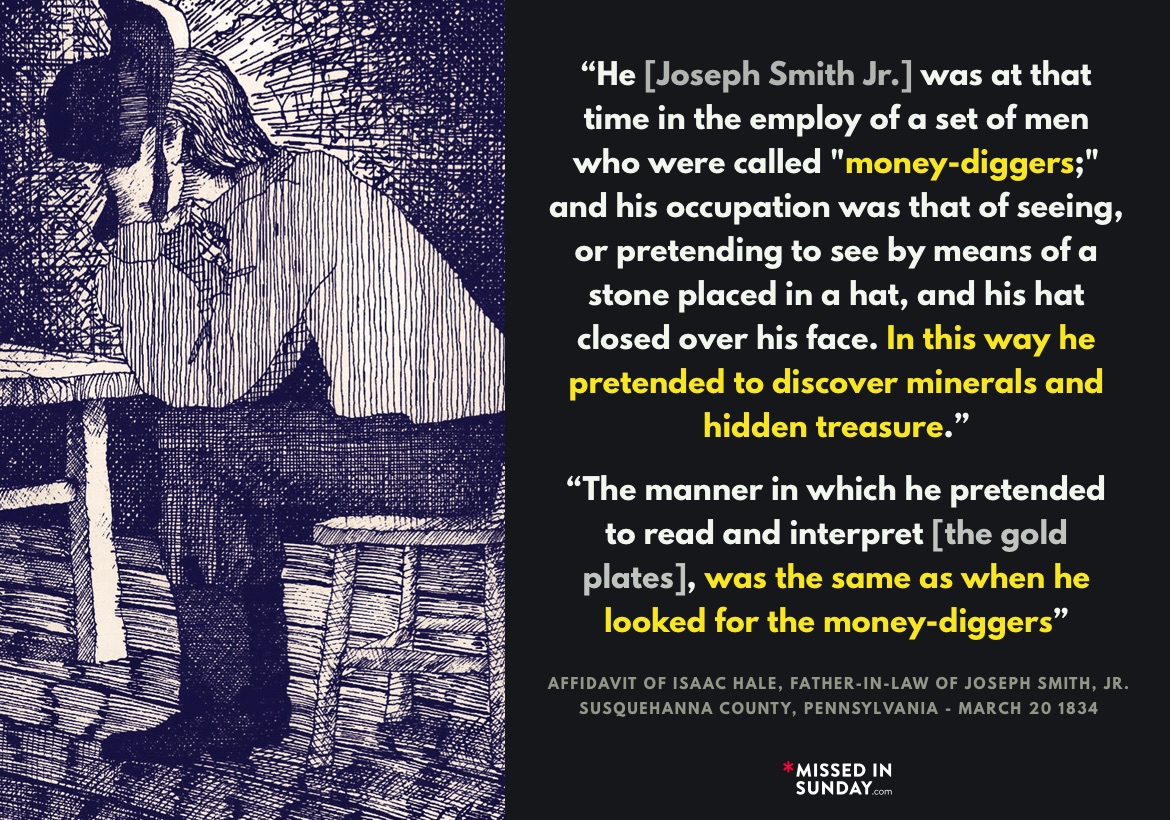
The reason why I put it in quotes is because it's an air quote to emphasize that this is not a literal statement or claim that Joseph used an actual Ouija Board but rather a non-literal statement to convey that Joseph was using a magic occult device to "communicate" to the supernatural realm - similarly to the purpose of the modern occult Ouija Board device to "receive" supernatural messages.
It's called "air quotes", Jim, which designates that what one is saying when using this should not be taken at face value as they are making a non-literal point to make a point.
The problem here is that you took me at face value on this just like you bizarrely took me at face value with my Lion King and Mufasa rhetorical questions. It's so bizarre and strange how literally you take me with obvious non-literal statements designed to make other underlying points.
Peep Stone
He put a rock – called a “peep stone” – in his hat...
So is it a peep stone or a Ouija Board? Both are in quotes, suggesting someone with some authority gave them both these labels, which they didn’t.
Jeremy's Response

See my previous box answer for my response to Jim's bizarre and strange literalism problem along with a quick lesson on air quotes.
"peep stone...suggesting someone with some authority gave these labels, which they didn't"
I got it from Bruce R. McConkie's Mormon Doctrine; the de facto authoritative book on Mormonism that I saw paraded around at Church throughout my youth:
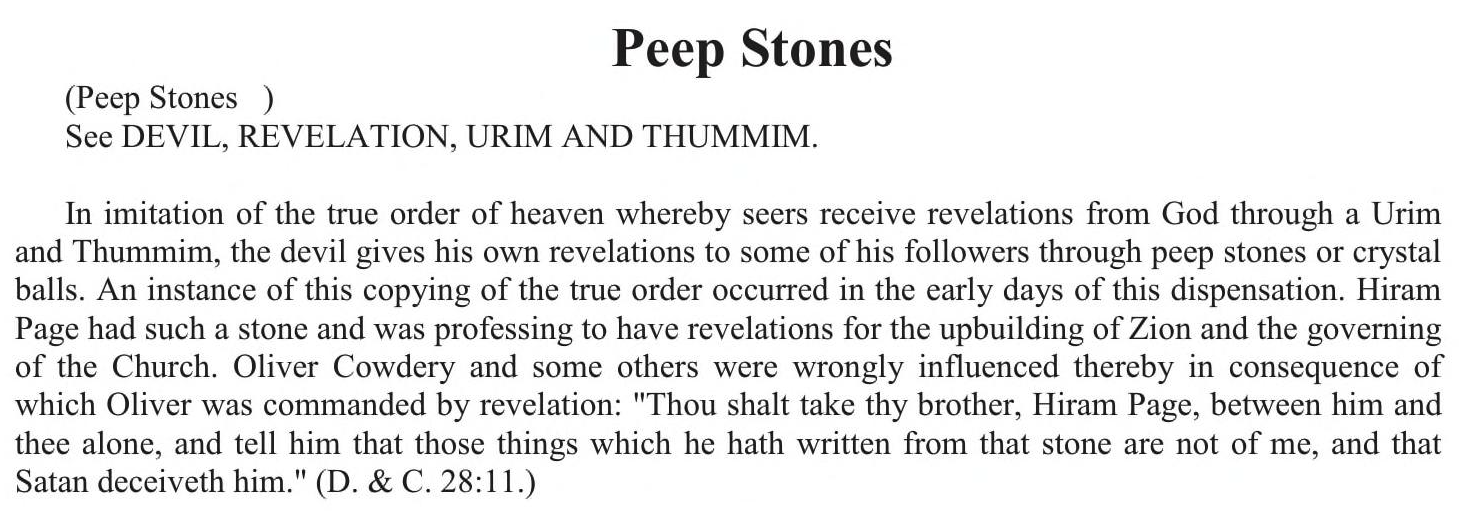
Can't get any more official than that.
Disclaimer: Jim...that was a joke. Do not take this literally. I repeat: THIS IS NOT LITERAL. Do not write another 372-page diatribe about how Jeremy thinks Mormon Doctrine was translated by Mufasa using an Ouija Board in the Wilkinson Center.
Here's the funny thing...history is written by the victors. When people that the Church, its leaders and its apologists don't like are using rocks in ways it doesn't think are legit? Like in the case of Hiram Page? It's "peep stone".
But when it's Joseph Smith doing the exact same thing for treasure digging and "translating" the Book of Mormon? Oh, it's "seer stone" instead.
Seer stone when we want to look legit. Peep stone when it's obvious bullshit.
I'm just playing by the same rules that the Church plays here by pointing out that Joseph's use of his folk magic occult non-Moroni-found-in-my-neighbor's-well-a-year-before-Moroni rock that he used to defraud people with is...well, bullshit - er, I mean, peep stone.
Language and labels are powerful. The Church knows this. This is why it does everything it can to obscure and mask the true folk magic / occult origins of the device used for "translating" the Book of Mormon by using supernatural and divine sounding names like "seer stone", "Nephite Interpreters" and "Urim and Thummim" when the reality is that it was just a rock...that Joseph found...in his neighbor's well...a year before Moroni. It was just a prop Joseph used to deceive people - both in treasure digging as well as when he was in front of gullible people like Martin Harris and the Whitmers while "translating" the Book of Mormon.
It was just as much a "peep stone" as Hiram Page's "peep stone". I just refuse to play along with the Church's masking and concealment propaganda efforts to keep members in the dark about its true disturbing folk magic / occultism origins.
"There's a lot of confusion about how Joseph Smith produced the Book of Mormon. This confusion is largely due to Joseph Smith's attempts to suppress the occult or folk magic - not satanic - origins and coming forth of the Book of Mormon. Mormon apologists have confused matters by trying to harmonize Joseph's official history with eyewitness testimony by claiming that Joseph Smith alternated between methods and simply chose to emphasize one over the other."
-Dan Vogel, Mormon historian and scholar
Joseph Smith's Magic Spectacles
"He [Joseph Smith] adopted the term 'Urim and Thummim' to refer to the spectacles as a means of suppressing its origins in the occult."
-Dan Vogel, Mormon historian and scholar
Joseph Smith's Magic Spectacles
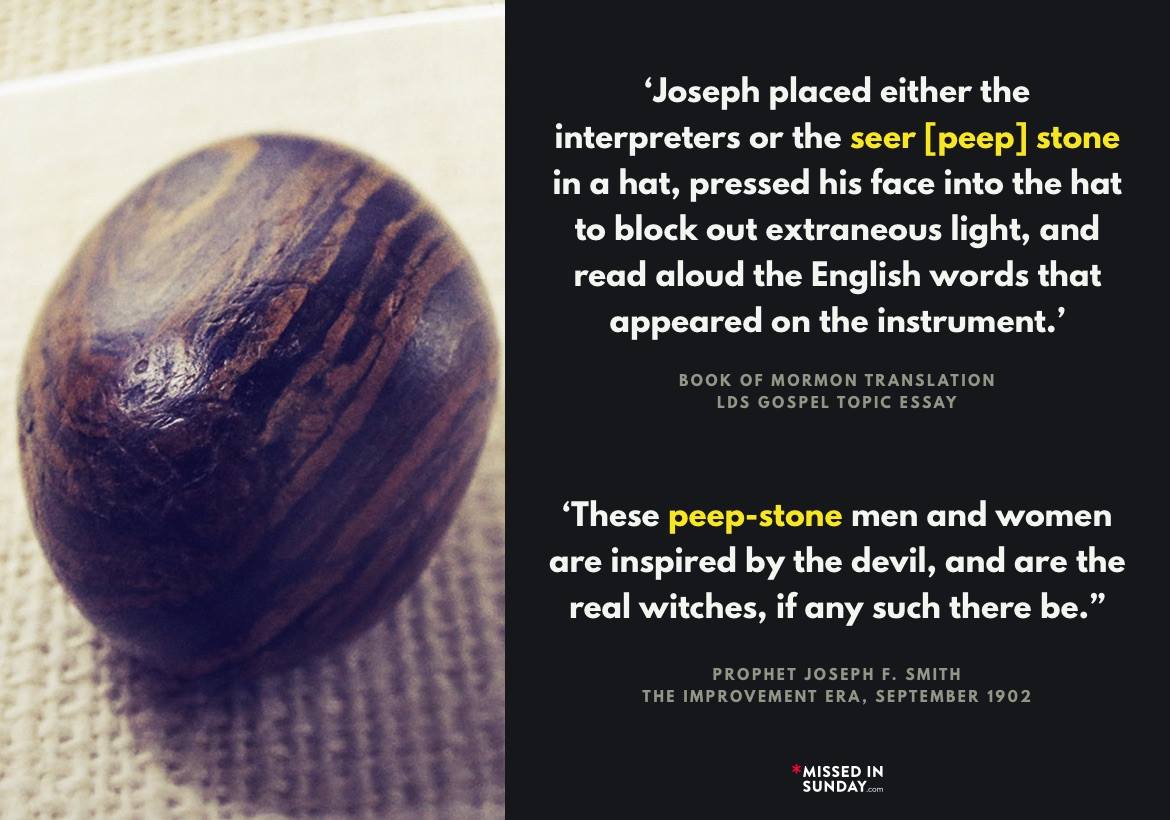
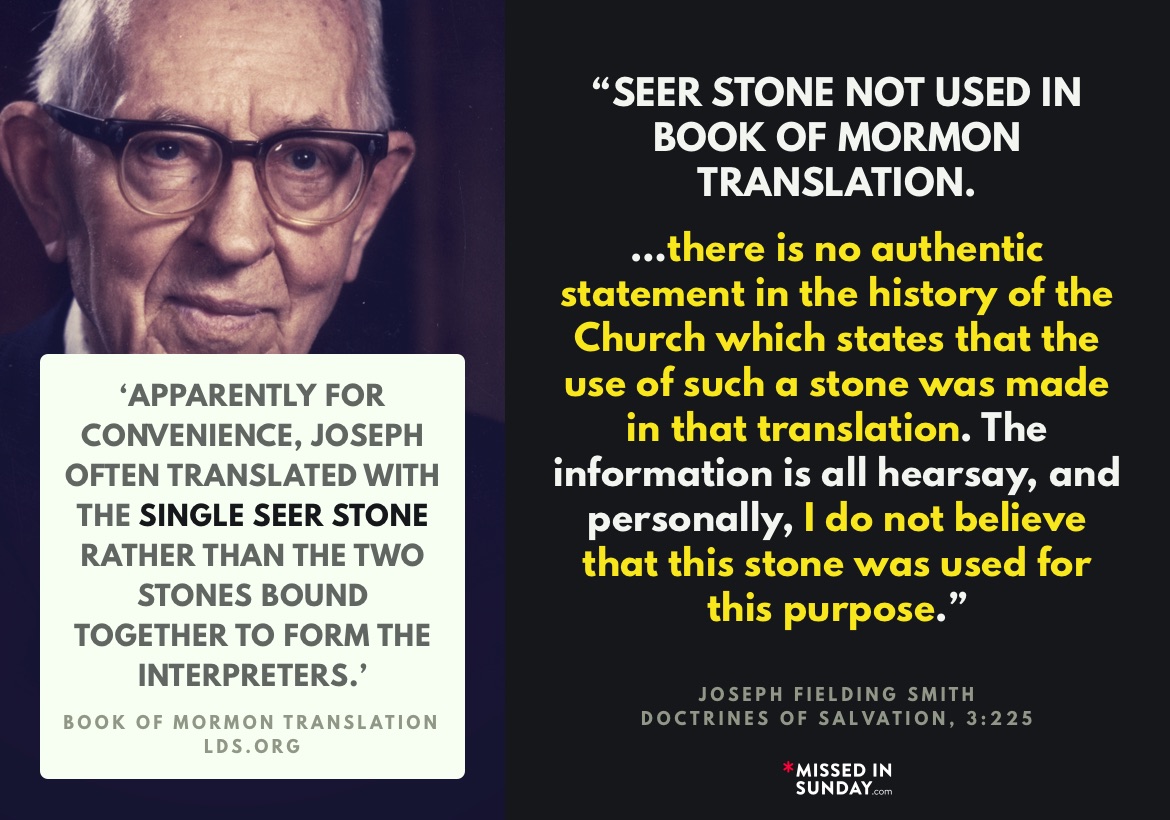
Revised purpose for gold plates: prop for the witnesses
...and put his face in the hat to tell his customers the location of buried treasure on their property. He also used this same method for translating the Book of Mormon, while the gold plates were covered, placed in another room, or even buried in the woods. The gold plates were not used for the Book of Mormon we have today.
That last sentence is a curious one, as it presupposes only a single way in which the gold plates could have been “used for the Book of Mormon.” Given that Joseph Smith didn’t know how to read Reformed Egyptian, any method in which he could have translated the characters on the plates would have required divine intervention. As such, what difference does it make whether that intervention makes use of the physical plates or not?
That does not mean, however, that the plates were useless. They were extraordinarily useful. You began this section with a quote from Richard Bushman to imply that this great scholar and faithful Church member agrees with you on this point. (He does not.)
The Bushman quote I added to your opening of this section points out that the plates are “a powerful form of evidence that the Lord gave to Joseph Smith and to us of the actuality of all these experiences” and provide “some of the most gritty and appealing parts of the Mormon story.” They were used for the testimony of the witnesses and the instruction of the prophet in preparing to obtain them. It is not at all correct to say that they were “not used for the Book of Mormon we have today.”
Jeremy's Response
Compare Jim's flowery apologetics of the plates to what LDS scholar and historian Richard Bushman actually says:
“I will begin by saying that we still have pictures on our Ward bulletin boards of Joseph Smith with the Gold Plates in front of him. That has become an irksome point and I think it is something the church should pay attention to. Because anyone who studies the history knows that is not what happened. There is no church historian who says that is what happened and yet it is being propagated by the church and it feeds into the notion that the church is trying to cover up embarrassing episodes and is sort of prettifying its own history.
So, I think we ought to just stop that immediately. I am not sure we need a lot of pictures in our chapels of Joseph looking into his hat, but we certainly should tell our children that is how it worked... It’s weird. It’s a weird picture. It implies it’s like darkening a room when we show slides. It implies that there is an image appearing in that stone and the light would make it more difficult to see that image. So, that implies a translation that’s a reading and so gives us a little clue about the whole translation process. It also raises the strange question, ‘What in the world are the plates for? Why do we need them on the table if they are just wrapped up into a cloth while he looks into a seer stone?’”
– RICHARD BUSHMAN, LDS SCHOLAR, HISTORIAN, PATRIARCH
FAIRMORMON PODCAST, EPISODE 3: RICHARD L. BUSHMAN P.1, 47:251 - emphasis added
Richard Bushman, in a December 31, 2020 Salt Lake Tribune interview (emphasis added):
Reporter:
Have you changed your mind over the years about any of the church’s founding events?
Richard Bushman:
In terms of the particulars — the overall story about the First Vision, gold plates, translation and a set of revelations to form a church — my view remains pretty much the way it was. But I do think about some things differently.
The Book of Mormon is a problem right now. It’s so baffling to so many that Joseph was not even looking at the gold plates [to translate them]. And there’s so much in the Book of Mormon that comes out of the 19th century that there’s a question of whether or not the text is an exact transcription of Nephi’s and Mormon’s words, or if it has been reshaped by inspiration to be more suitable for us, a kind of an expansion or elucidation of the Nephite record for our times. I have no idea how that might have worked or whether that’s true. But there are just too many scholars now, faithful church scholars, who find 19th-century material in that text. That remains a little bit of a mystery, just how it came to be.
In a private June 12, 2016 fireside, Mr. Bushman concedes that "the dominant narrative is not true; it can't be sustained.":
Gone are the days where the narrative for the gold plates was that they were for the purpose of translating the Book of Mormon. Now? "The plates were useful as a prop for the witnesses."
All that damn work of cutting Laban's head off, etching and carving Reformed Egyptian onto gold plates and the serious hassles of abridging the plates were all done so that gullible 19th-century treasure digging family and friends of Joseph's, with magic worldviews, could "see" them.
Mark Twain joked about the absurdity of having the Smith family and the Whitmer family as majority "witnesses":
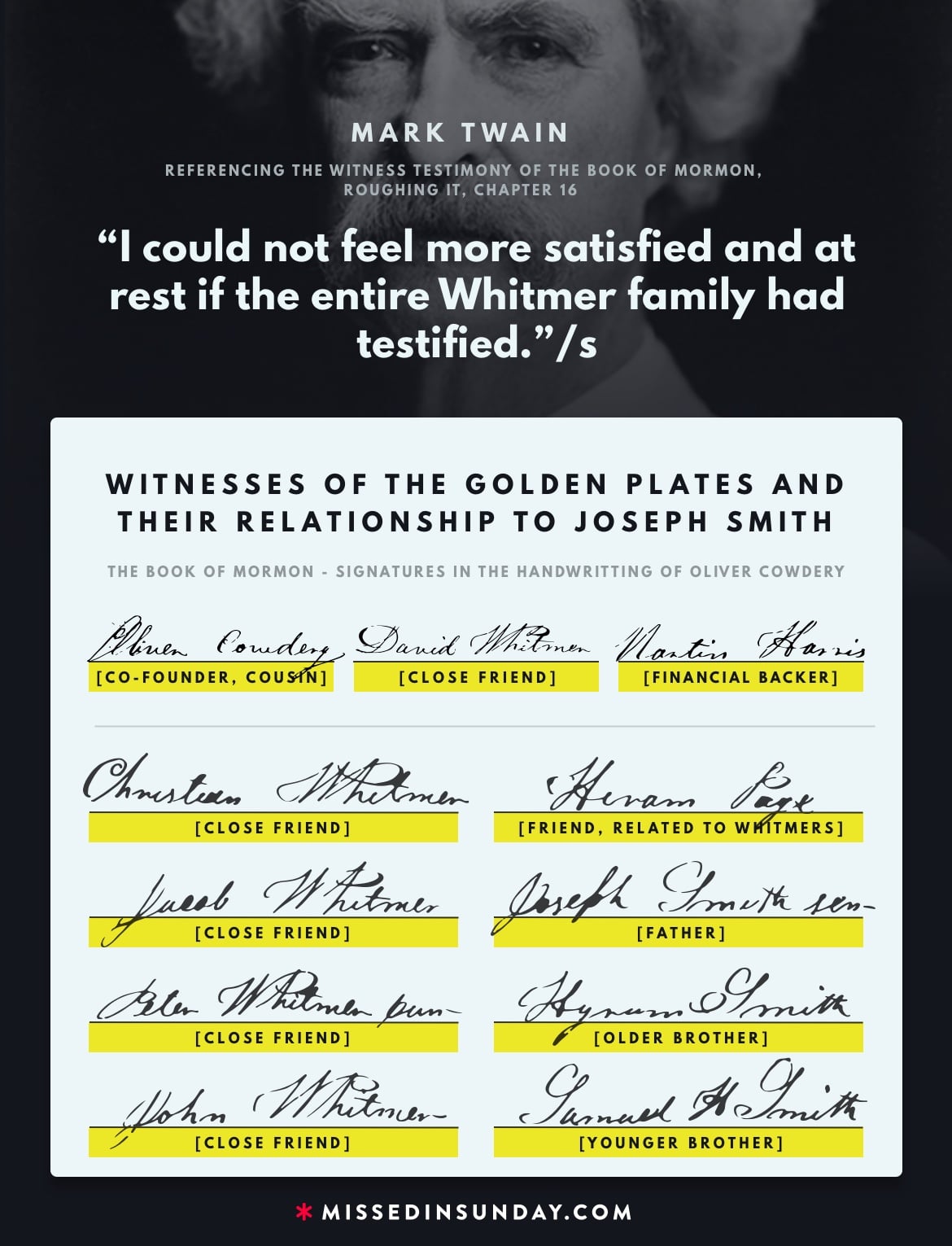
We discuss the problems with the witnesses in the Witnesses section of the CES Letter and here in the Debunkings.
Apparently you didn't read your own Mission President's essay, Jim. I would have loved to have been a fly on the wall watching 2018 Jim Bennett present his crazy ad hoc "but...but the plates were useful...for the witnesses!" idea and apologetics to Joseph Fielding McConkie in 2000 around the time he wrote his “The Process of Translating the Book of Mormon” essay; that Jim doesn't want his readers to read. I'll let Jim's Mission President, Brother McConkie (whom I had the pleasure of meeting during my BYU days), finish debunking Jim's insanity on my behalf here as Brother McConkie says it better than I can:
Mission Prez vs. Jim
"Finally, [the rock-in-the-hat translation method] simply does not accord with the divine pattern. If Joseph Smith translated everything that is now in the Book of Mormon without using the gold plates, we are left to wonder why the plates were necessary in the first place. It will be remembered that possession of the plates placed the Smith family in considerable danger, causing them a host of difficulties. If the plates were not part of the translation process, this would not have been the case.
It also leaves us wondering why the Lord directed the writers of the Book of Mormon to make a duplicate record of the plates of Lehi. This provision which compensated for the loss of the 116 pages would have served no purpose either.
Further, we would be left to wonder why it was necessary for Moroni to instruct Joseph each year for four years before he was entrusted with the plates. We would also wonder why it was so important for Moroni to show the plates to the three witnesses, including David Whitmer. And why did the Lord have the Prophet show the plates to the eight witnesses? Why all this flap and fuss if the Prophet didn't really have the plates and if they were not used in the process of translation? [lol!]
What David Whitmer [and my former missionary Jim Bennett] is asking us to believe is that the Lord had Moroni seal up the plates and the means by which they were to be translated hundreds of years before they would come into Joseph Smith's possession and then decided to have the Prophet use a seer stone found while digging a well so that none of these things would be necessary after all.
Is this, we would ask, really a credible explanation of the way the heavens operate?"
- Joseph Fielding McConkie,
The Process of Translating the Book of Mormon"
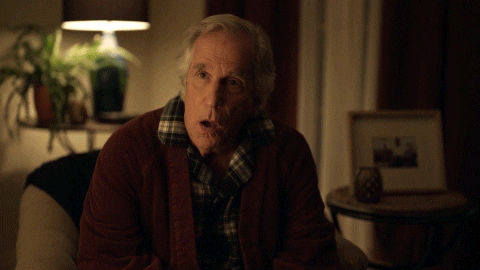
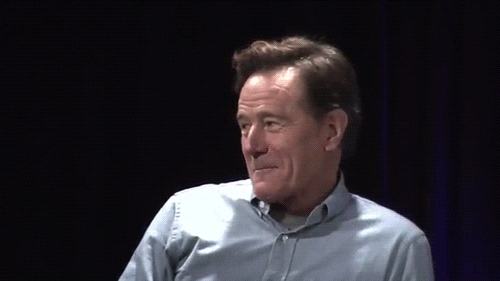
Jim's translation obfuscation attempts
Update: These facts are now officially confirmed in the Church’s December 2013 Book of Mormon Translation essay.
Not sure how this is an update, as you mentioned the essay in the previous version of your letter. What you don’t mention is that the Church also confirms that the rock in the hat was not the only method of translation, and that the plates were, in fact, used for part of the translation process.
From the Church’s essay:
Nevertheless, the scribes and others who observed the translation left numerous accounts that give insight into the process. Some accounts indicate that Joseph studied the characters on the plates. Most of the accounts speak of Joseph’s use of the Urim and Thummim (either the interpreters or the seer stone), and many accounts refer to his use of a single stone. [Emphasis added]
Jeremy's Response
I wrote the CES Letter in March and April 2013 (which you saw the evidence of in our December 2020 meeting, Jim). The December 2013 Book of Mormon Translation essay (and all other essays) did not exist when I wrote my original letter to the CES Director.
The "Update" phrase is to communicate to my readers that the Church's essays did not exist when I wrote the letter to the Director in April 2013 and that it came later.
Actually, what you don't mention here, Jim, is which translation of the Book of Mormon Joseph "studied the characters on the plates". It was the first translation before the loss of the 116 pages and Moroni showed up to take away the gear as a consequence.
The Book of Mormon we have today came after the loss of the 116 pages and it was this translation that no gold plates were used. It was Joseph's brown treasure digging rock he found in his neighbor's well a year before Moroni along with his hat that were used for today's Book of Mormon translation.
Nice try attempting to obfuscate and mislead your readers by not clarifying these two different translations and that the plates were not used for the latter one that Joseph used his brown treasure digging stone for.
For more information on all of this, see Overview.
Admits
The Church later admitted these facts in its October 2015 Ensign, where they include a photograph of the actual rock that Joseph Smith used to place in his hat for the Book of Mormon translation. Additional photos of the rock can be viewed on lds.org.
Also above. And how could the Church later “admit” what they’d already admitted in the essay two years earlier? Admissions are statements that reveal new information. Every mention of the rock in the hat by the Church cannot be defined as an admission.
In this version, you took out the reference to then-Elder Nelson’s 1992 talk about the rock in the hat. that admissions precedes the essay “admission” by nearly two decades. How many times does the Church have to admit - or “re-admit” - this information before you stop acting like each new mention is the first time?
Jeremy's Response
The Church officially admitted this in its obscure December 2013 Book of Mormon Translation essay that the vast majority of the membership still do not know about in . There are even Bishops and Stake Presidents that still do not know about the essays in .
When the Church later admitted about the rock in its October 2015 Ensign, it was a completely different kind of admission and transparency on a mass channel (Ensign) that, unlike the more hidden essay, a larger percentage of the Church membership would see.
But yes, it will continue to be an admission as long as the Church is still peddling its false gold plates translation narrative - that is still being perpetuated in 2021 - to its entire membership:
This is a screenshot of the recent January 2021 Liahona. Look at the inaccurate gold plates "translation" still being portrayed to the general membership:
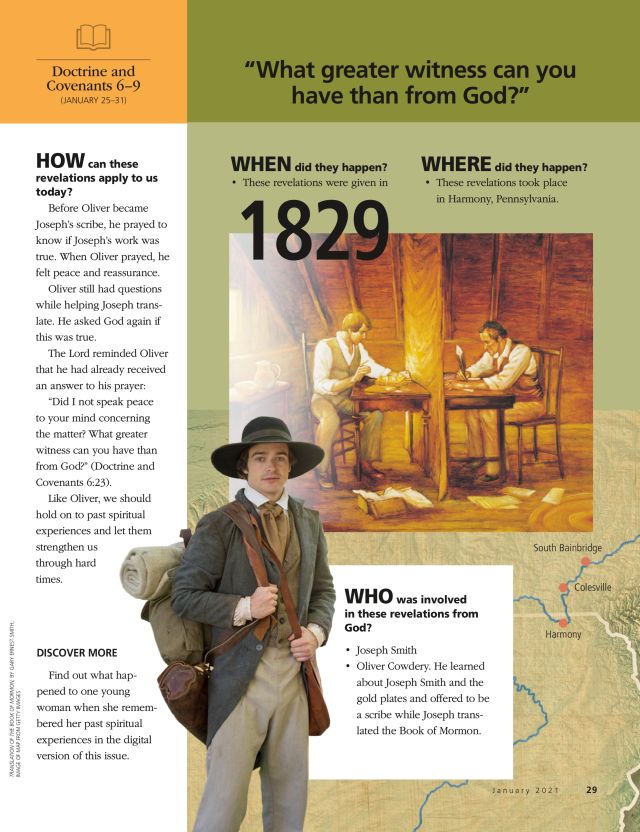
This is a screenshot from the recent January 2021 Friend magazine:
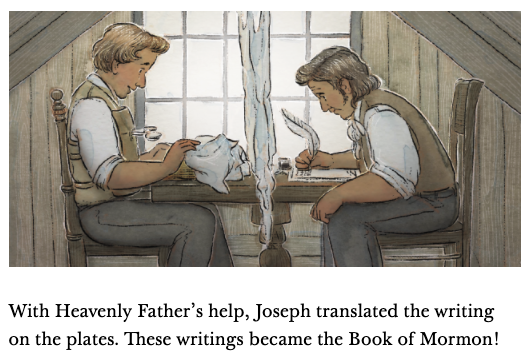
"In this version, you took out the reference to then-Elder Nelson’s 1992 talk about the rock in the hat. that admissions precedes the essay “admission” by nearly two decades. How many times does the Church have to admit - or “re-admit” - this information before you stop acting like each new mention is the first time?"
Elder Nelson's 1992 talk was just Elder Nelson - not the Church - talking about the rock in the hat. It had no official weight as the Church carried on with its false gold plates translation narrative in its entire Correlation, Seminary lessons, Missionary discussions, Ensign fake pictures and articles and General Conference talks after this that peddled the false translation narrative. It's also evident in the understanding and assumptions of two BYU religious professors in the year 2000 - as I talked about in the CES Letter and which I'll talk about more below.
Pointing to Elder Nelson's obscure 1992 talk as evidence of Church transparency is like the bullshit stunts that FairMormon plays in attempting to claim the Church has been transparent all along. They point to crazy obscure 1970s stuff that no investigator or member had any hope of finding as "evidence" of Church transparency.
Jim's little fake scandal baking here in attempting to paint me as evil-mustache-twirling with nefarious intent is just stupid. The reason why Elder Nelson's 1993 talk is no longer in the CES Letter is because it's bigger than Elder Nelson now as the Church itself has made official declarations and announcements with its essay as well as other announcements in the Ensign.
I wrote about Elder Nelson in my original CES Letter in March 2013 because that was the most credible Church source at the time to show that I wasn't making up the rock in the hat translation. The Church later provided stronger evidence with its official essay and so I focused on that instead.
Sorry, Jim. There's nothing nefarious or sinister going on here. I just chose to focus and emphasize the recent Church's official and heavier statements and releases on this topic.
"Church isn't trying to hide"
In June 2016, President Dieter F. Uchtdorf posted on his Facebook page comparing the seer stone in the hat Book of Mormon translation to his iPhone. FairMormon posted new Book of Mormon translation artwork showing Joseph Smith’s face in a hat.
So many admissions! If I didn’t know any better, I’d almost believe that the Church isn’t trying to hide this information. (Except for the hat. Where’s the freakin’ hat?!)

Jeremy's Response

Where do I even begin with this stupid snark and bullshit statement and strawman?
Oh, I know...I'll let 2021 Jim debunk this:
"I felt like a chump"
Rather than acknowledge the Church's lack of transparency like Jim does in his 2021 Mormon Stories interviews, 2018 Jim attempts to obfuscate here by giving the impression that the Church's present increased transparency has always been the norm and the same behavior and transparency the Church exhibited in generations past, when the Church didn't.
Fortunately, Jim clarifies and validates my point of past cover-up (Jim calls it "downplay") in the next section with his statement: "Indeed, there is accumulating evidence that the Church is no longer trying to downplay the rock and/or the hat at all."
I respond to Jim's above statement in the next box answer.
It's a strawman of Jim's to imply that I'm saying that the Church is not more open and transparent about the rock-in-the-hat today. They are and they have been the most transparent they've ever been in recent years on this topic. I'm saying that they hid, covered-up and suppressed this information for generations past and that the Church unfortunately is still not fully transparent and honest about it today. Yes, the Church talks about the rock-in-the-hat in some places like the more obscure Gospel Topics essay but they also still misled members in 2021 with fake translation art in the Liahona and Friend magazines - as demonstrated in the next answer box.
I spent 30 years in Mormonism before I learned about the rock-in-the-hat for the very first time - after an honorable 2 year mission, seminary in high school, EFYs (attendee and counselor), regular activity and Church attendance, and BYU.
I have family members who have been very active in Mormonism their entire lives not knowing about the rock-in-the-hat until their 60s.
Jim spent ~19 years before learning it from his apostle's son mission president and believed it was a lie / false claim until his late 40s when he read the Church's essay in recent years and accepted the fact - as shown in the above video.
Jim on Church Hiding Church History
Rather than just simply acknowledging the real problem of this and the sense of betrayal and disgust that members of the Church are feeling by discovering the Church's deception and cover-up about the rock-in-the-hat - for generations - Jim instead attempts to trivilize and demean here with his dumb and irrelevant "wHeRe'S tHe FrEaKiN' hAt?!" snark and graphic.
"Church no longer trying to downplay"
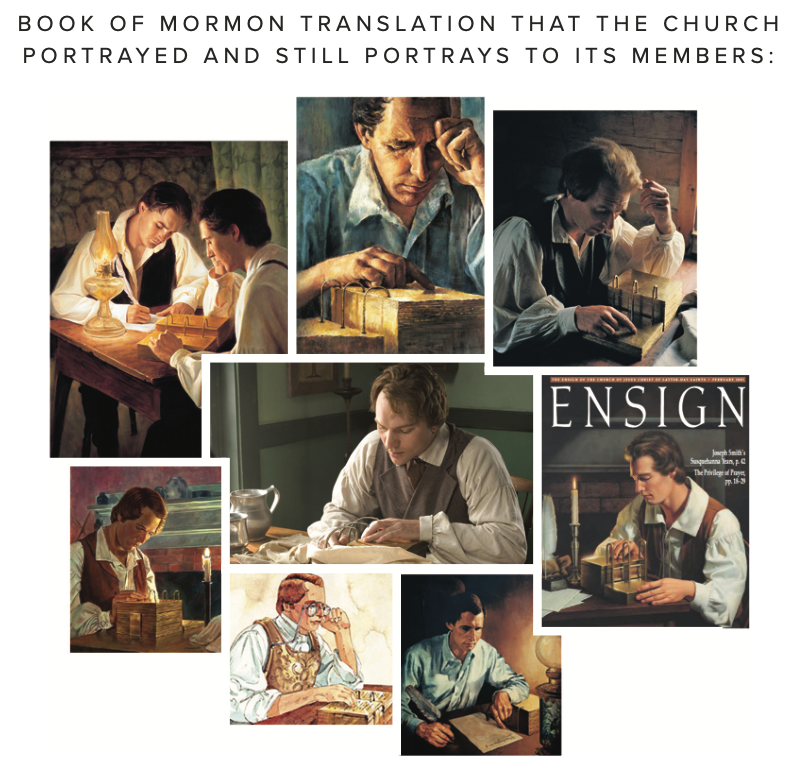
“Still portrays” is belied by the fact that these images are all at least a decade old, if not older. (That Ensign is dated 2002.) I could be wrong, but I haven’t seen anything like this since the 2013 essay.
Indeed, there is accumulating evidence that the Church is no longer trying to downplay the rock and/or the hat at all. The release of Saints: The Story of the Church of Jesus Christ in the Latter Days demonstrates an openness and candor that is likely to serve the Church well in the days ahead.
A noteworthy excerpt from Chapter 6 of the first volume:
Meanwhile, Joseph and Oliver started translating. They worked well together, weeks on end, frequently with Emma in the same room going about her daily work. Sometimes Joseph translated by looking through the interpreters and reading in English the characters on the plates.
Often he found a single seer stone to be more convenient. He would put the seer stone in his hat, place his face into the hat to block out the light, and peer at the stone. Light from the stone would shine in the darkness, revealing words that Joseph dictated as Oliver rapidly copied them down.
That account, of course, is more consistent with your next batch of pictures.
Jeremy's Response
"...Church is no longer trying to downplay the rock and/or the hat at all."
- 2018 Jim Bennett
Greetings from the future, Jim. 👋
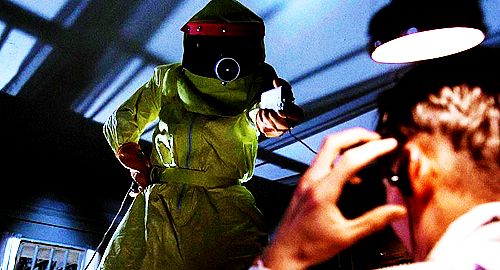
It's now 2021 and I'm sad to report that the Church is still misleading the overall membership by continuing to showcase fake and inaccurate Book of Mormon translation art and images in its mass produced magazines:
This is a screenshot of the recent January 2021 Liahona. Look at the inaccurate gold plates "translation" still being portrayed to the general membership:

This is a screenshot from the recent January 2021 Friend magazine:

Here's a screenshot from the Joseph Smith Translates the Gold Plates page on the Church's website (accessed October 24, 2021):
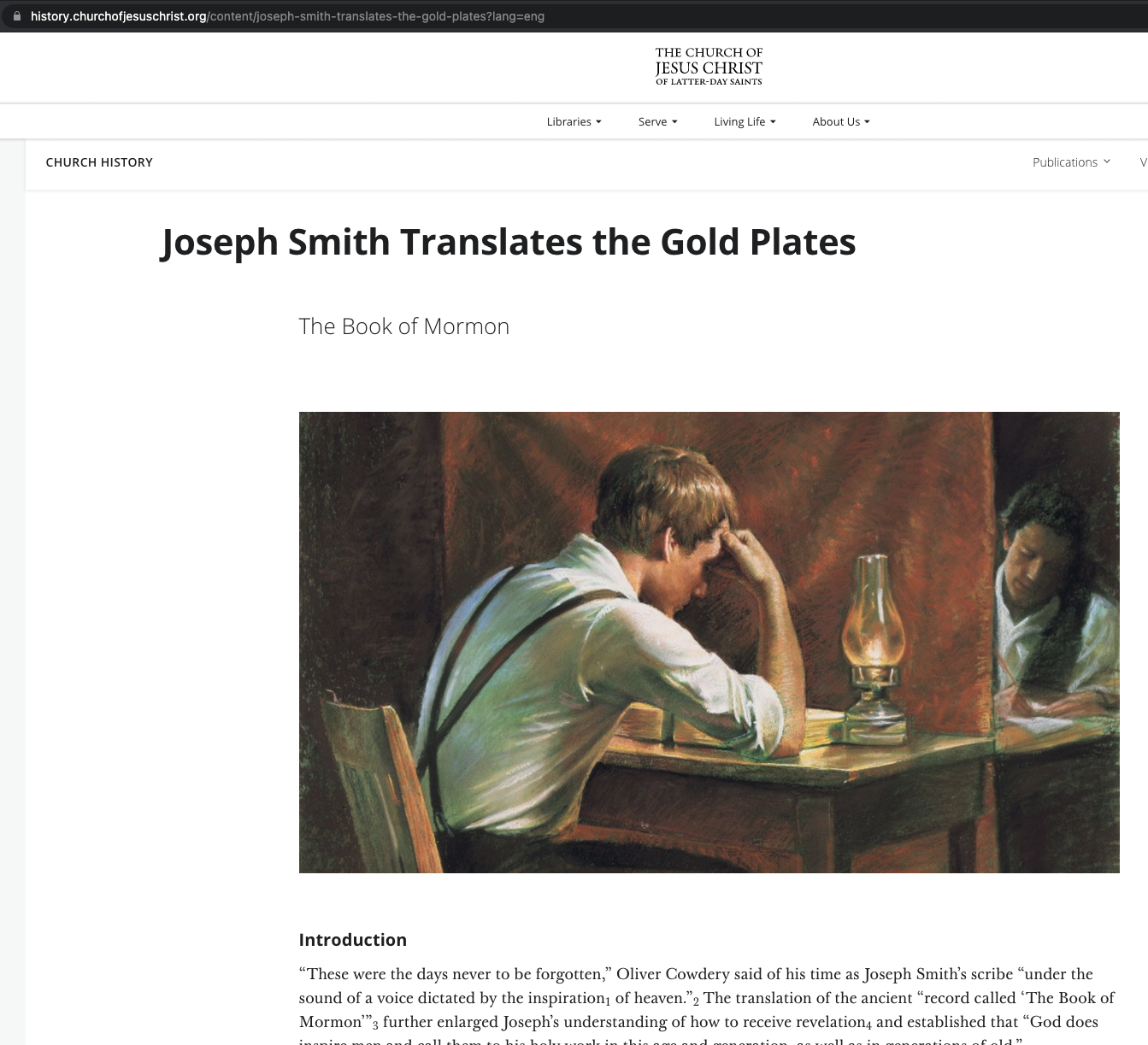
I know, Jim...me too.
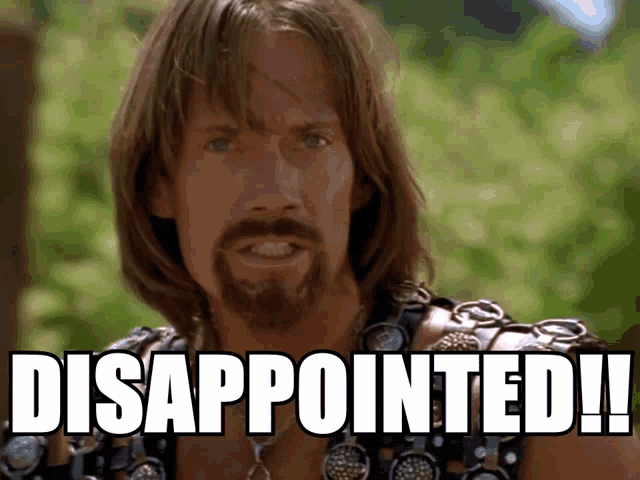
Jim misleads and confuses with irrelevant translation
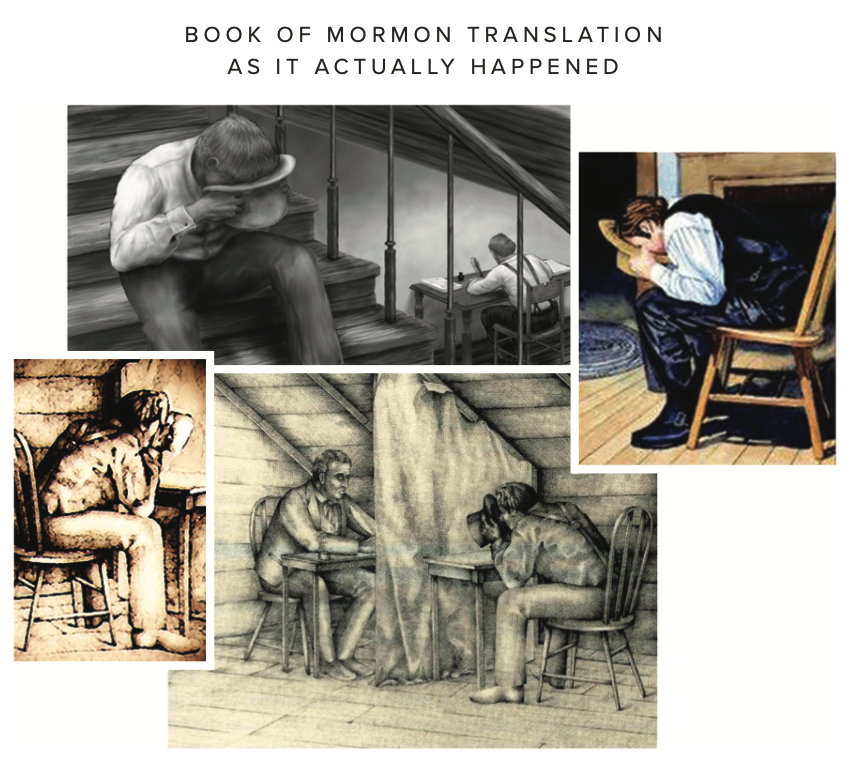
Important correction: these pictures only depict part of how “it actually happened,” as this was not the only method of translation. Accounts suggest that the first 116 pages were done entirely with the Urim and Thummim, which would make the first batch of pictures much less misleading than your heated reaction allows.
Jeremy's Response
This is misleading.
Questions: Are the first 116 pages in the Book of Mormon we have today? Was the translation of the first 116 pages part of the translation of the Book of Mormon that we have today?
Answers: No and no.
So, the first 116 pages and how they were translated are irrelevant to the Book of Mormon we have today and how the Book of Mormon we have today was translated. When the 116 pages were lost, Joseph had to start over anew with his folk magic occult rock he used to defraud people out of their money (treasure digging).
It doesn't matter how the 116 pages were translated because the Book of Mormon we have today wasn't translated in the same way. The Urim and Thummim were removed from Joseph by the Angel Moroni after the 116 pages were lost.
After Joseph lost the Urim and Thummim, he used his occult brown-rock-that-I-found-in-1822-in-my-neighbor's-well-that-I-used-in-my-treasure-digging-con-jobs-to-defraud-my-customers to start "translating" - entirely from scratch - the Book of Mormon we have today.
This is just Jim's disingenuous and misleading attempt to obfuscate and muddy the waters in trying to mask the disturbing folk magic / occult side of this from his readers by attempting to mix the sole occult device with a divine "Urim and Thummim".
My statement and the images stand valid and correct as how the 116 pages were translated is irrelevant to the translation of the Book of Mormon we have today.
See the "Urim and Thummim was, in fact, used during translation" section for more debunking on Jim's false claim here along with sources, including FairMormon, admitting that that the Book of Mormon we have today was translated with Joseph's brown occult rock.
Bushman Misrepresentation
Respected LDS historian and scholar Richard Bushman, as quoted above, understands the problem.
And yet, as demonstrated by my additional quote above, you fail to understand or accurately represent Richard Bushman’s position on the subject.
Jeremy's Response
No, Jim. You fail to understand or accurately represent Bushman's position on the subject. Your outdated additional quote is from a 2010 presentation. My quote is from a day short of 2021 (over a decade after your quote):
Richard Bushman, in a December 31, 2020 Salt Lake Tribune interview (Red emphasis added):
Have you changed your mind over the years about any of the church’s founding events?
In terms of the particulars — the overall story about the First Vision, gold plates, translation and a set of revelations to form a church — my view remains pretty much the way it was. But I do think about some things differently.
The Book of Mormon is a problem right now. It’s so baffling to so many that Joseph was not even looking at the gold plates [to translate them]. And there’s so much in the Book of Mormon that comes out of the 19th century that there’s a question of whether or not the text is an exact transcription of Nephi’s and Mormon’s words, or if it has been reshaped by inspiration to be more suitable for us, a kind of an expansion or elucidation of the Nephite record for our times. I have no idea how that might have worked or whether that’s true. But there are just too many scholars now, faithful church scholars, who find 19th-century material in that text. That remains a little bit of a mystery, just how it came to be.
In a private June 12, 2016 fireside (6 years after your added Bushman quote you're using to try to beat me with), Mr. Bushman makes your quote obsolete by conceding that "the dominant narrative is not true; it can't be sustained.":
BYU Professors Denounce rock-in-hat in 2000
In 2000, two BYU religion professors, Joseph Fielding McConkie (son of Elder Bruce R. McConkie) and Craig J. Ostler, wrote an essay titled, “The Process of Translating the Book of Mormon.” They wrote:
“Thus, everything we have in the Book of Mormon, according to Mr. Whitmer, was translated by placing the chocolate-colored stone in a hat into which Joseph would bury his head so as to close out the light. While doing so he could see ‘an oblong piece of parchment, on which the hieroglyphics would appear,’ and below the ancient writing, the translation would be given in English. Joseph would then read this to Oliver Cowdery, who in turn would write it. If he did so correctly, the characters and the interpretation would disappear and be replaced by other characters with their interpretation.”
After laying the groundwork, the professors continue:
“Finally, the testimony of David Whitmer simply does not accord with the divine pattern. If Joseph Smith translated everything that is now in the Book of Mormon without using the gold plates, we are left to wonder why the plates were necessary in the first place. It will be remembered that possession of the plates placed the Smith family in considerable danger, causing them a host of difficulties. If the plates were not part of the translation process, this would not have been the case. It also leaves us wondering why the Lord directed the writers of the Book of Mormon to take a duplicate record of the plates of Lehi. This provision which compensated for the loss of the 116 pages would have served no purpose either.
Further, we would be left to wonder why it was necessary for Moroni to instruct Joseph each year for four years before he was entrusted with the plates. We would also wonder why it was so important for Moroni to show the plates to the three witnesses, including David Whitmer. And why did the Lord have the Prophet show the plates to the eight witnesses? Why all this flap and fuss if the Prophet didn’t really have the plates and if they were not used in the process of translation?
What David Whitmer is asking us to believe is that the Lord had Moroni seal up the plates and the means by which they were to be translated hundreds of years before they would come into Joseph Smith’s possession and then decided to have the Prophet use a seer stone found while digging a well so that none of these things would be necessary after all. Is this, we would ask, really a credible explanation of the way the heavens operate?”
Those are good questions. I was first introduced to the rock in the hat in 1989 when the ideas of this essay were delivered live in a zone conference by Pres. McConkie himself. As I mentioned earlier, this, more than the inherent weirdness of the rock in the hat, is probably why Whitmer’s account isn’t widely discussed, because the McConkies and the Fielding Smiths didn’t think Whitmer, at such a late date and because of his disaffected status, was a reliable source on the subject. And there’s the possibility that they may well be right, that the current interpretation of the historical narrative is incorrect, and that the conventional wisdom was right the first time.
I confess that I, personally, lean in that direction...
Jeremy's Response
This is 2018 Jim activating Jim Bennett Mormonism® by contradicting the Brethren and their December 2013 Book of Mormon Translation Gospel Topics essay verified fact.
In 2021, Jim contradicts his above 2018 statement and has changed his mind on the issue by acknowledging that the Church and David Whitmer are indeed correct and the McConkies and Fielding Smiths were wrong:
"I felt like a chump"
What doesn't make sense here is that in the above 2021 video, Jim points to the above-mentioned December 2013 Book of Mormon Translation Gospel Topics essay as the catalyst for changing his mind on the issue.
Jim's above 2018 statement was written close to 5 years after the Church's essay came out. I've talked about this essay in the CES Letter. Jim talks about this essay and even quotes from it in his 2018 Jim Bennett Mormonism® Manifesto while also contradicting the essay by "leaning" in the direction that "they [McConkies and Fielding Smiths] may well be right, and that the current interpretation [the Church's 2013 Book of Mormon Translation Gospel Topics essay approved by the Brethren]...is incorrect".
This glaring contradiction is problematic but I'm going to do something here for Jim that he never does for me in his Jim Bennett Mormonism® Manifesto: be charitable. I could turn this into a nefarious and sinister conspiracy on Jim's part as he often does to me but here's what I think happened:
Jim went on a faith journey after he wrote this in September 2018 and he thought more about this and researched it more and realized that the LDS Church and LDS scholars are correct on the rock-in-the-hat narrative and the McConkies and the Fielding Smiths were wrong.
Jim has told me in 2021 that his original files for his Reply document have been corrupted and it's a nightmare to fix it all let alone correcting and updating the content. Consequently, he was never able to update this shortly after when he changed his mind on the rock-in-the-hat.
Moving on, keep in mind that Jim spent about 19 years in Mormonism before being introduced to the rock-in-the-hat by his apostle's Mission President son. Unfortunately, he was taught that the rock-in-the-hat was a lie and he believed it was a lie for the next 25-ish years until his late 40s when he read the Church's essay in recent years.
I didn't learn about the rock-in-the-hat until I was 30, before the Church's essay even came out, after a very active Mormon experience. My father didn't know until his mid-60s after decades of high activity in the Church. I see it all the time from very knowledgeable and active Latter-day Saints never knowing about the rock-in-the-hat. This ignorance is still pervasive within the membership of the Church even today despite the Church's scant attempts and mixed messages about it.
I confess that I, personally, lean in that direction based on D&C 9’s explanation that translation required study and effort beyond just reading words on a stone. The Book of Mormon also appears to be clothed in Joseph Smith’s language and vocabulary, which would suggest the prophet had a part in choosing the words. For my part, I don’t see the translation process as critical to a testimony of the Book of Mormon, so I am untroubled that my opinion is, at the moment, out of the mainstream. My opinion on a number of Church subjects is fairly heterodox, actually. I’m grateful the Church has far more room for a variety of points of view than you give it credit for.
In any case, what you’re encountering here is the reality that even prophets and apostles have differences of opinion. It’s disconcerting that, for you and many active Church members, the possibility of such differences still comes as a great surprise.
Jeremy's Response
This is Jim's Jim Bennett Mormonism® attempt to reframe the Book of Mormon translation as a "loose translation" instead of the "tight translation" that it was. You can learn more about Loose vs. Tight Translation here.
Notice that Jim admits that the Book of Mormon "appears to be clothed in Joseph Smith's language and vocabulary" (aka 19th-century fingerprints, signatures, theology, themes, etc.). As mentioned above, LDS scholars find this problematic and admit that there are 19th-century stuff and anachronisms in the Book of Mormon. Even 2021 Jim admits there are anachronisms in the Book of Mormon.
Rather than allow this to activate the litmus test for fraud alarm or raise red flags, Jim chooses to point to and advocate the unsupported and contradictory "loose translation" apologetic card in trying to address this problem.
But Jim goes no further than this as he throws in the towel and activates his Jim Bennett Mormonism® again:
"I don’t see the translation process as critical to a testimony of the Book of Mormon, so I am untroubled that my opinion is, at the moment, out of the mainstream. My opinion on a number of Church subjects is fairly heterodox, actually."
Jim gaslights us and attempts to convert the Book of Mormon translation process into a nothingburger that is "not critical to a testimony" while claiming that he's "untroubled". It's no surprise at all that Jim believes this and is "untroubled" because he clearly does not understand the core problem and threat of the rock-in-the-hat and folk magic / occultism. Jim has not only demonstrated his shocking ignorance all over his hit piece but he has even admitted several times throughout his document that he doesn't understand my problem with the rock-in-the-hat.
"I’m grateful the Church has far more room for a variety of points of view than you give it credit for." Yeah, tell that to the September Six and all the BYU and Mormon historians and scholars who have been threatened, disciplined, silenced, blacklisted and excommunicated over the years. The LDS Church is not a liberal institution that welcomes real diversity of thought and beliefs and debate regarding its truth claims and history.
Jim's Whitmer & McConkie deceptions
How could it have been expected of me and any other member to know about and to embrace the rock in the hat translation when even these two faithful full-time professors of religion at BYU rejected it as a fictitious lie meant to undermine Joseph Smith and the truth claims of the Restoration?
Well, two things.
First, I can confidently assert that President McConkie did not think the rock in the hat was a “fictitious lie meant to undermine Joseph Smith and the truth claims of the Restoration.” I have heard him speak about this firsthand. He bases his interpretation of Whitmer’s description on the fact that David Whitmer’s comments were decades removed from a process he did not himself witness, which means he may have gotten his facts wrong for any number of innocent reasons. He thought David Whitmer was mistaken, not that he was deliberately misleading anybody. Certainly Whitmer wasn’t trying to undermine the truthfulness of the Book of Mormon. He was true to his testimony of that sacred record throughout his life, even when he was deeply disaffected with Joseph Smith. President McConkie would have been the first to acknowledge that.
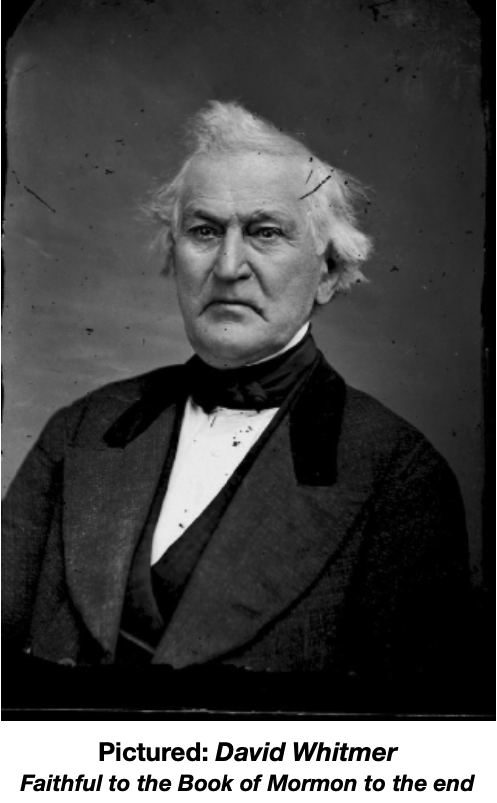
A lie requires deliberate intent to deceive. If you were to ask me how to get to my house, and I tell you to turn right instead of left at some point, it may well be that my atrocious sense of direction is to blame rather than dishonesty, and that I have made an honest mistake.
This also cuts to the heart of many of your objections against the Church. Every time you encounter fallibility in Church history, you immediately assume malicious intent when non-malicious human error is a more likely, and certainly more charitable, explanation for missteps.
Bad information often comes from well-intentioned sources. As a word of advice, I would caution you against characterizing all factual errors as lies, as you would be branding yourself a liar for the legions of mistakes that can be found in every version of the CES Letter.
Second, it was not “expected” of you to know about, let alone “embrace,” the rock in the hat. The Church, frankly, doesn’t particularly care what you, me, or anyone thinks about the translation process. To repeat, Joseph Smith himself said it “was not intended to tell the world all the particulars of the coming forth of the Book of Mormon.” It turns out you can be a faithful Latter-day Saint in full fellowship and ultimately be saved in the Celestial Kingdom of God regardless of your views on this particular subject, or even if you remain blissfully unaware of both the rock and the hat for the entirety of your mortal life.
Jeremy's Response
The one here who is presenting "bad information" is Jim Bennett with his grossly misleading and inaccurate Jim Bennett Mormonism® Manifesto.
Not only is Jim presenting bad information, he's misleading his readers here by obscuring a very important hyperlink to Joseph Fielding Smith's The Process of Translating the Book of Mormon essay. I expose and detail this deception of Jim's below.
Jim's entire above response is a strawman of what I'm actually saying. Jim is misrepresenting what I'm actually saying while running off with an irrelevant "lie vs. mistake" rant which ends up not only completely distracting his readers but completely ignoring and not answering the core argument and issue that I'm presenting here in the first place.
Jim has made the following false claims and presented them as facts to his readers several times in his Jim Bennett Mormonism® Manifesto:
"the fact that David Whitmer’s comments were decades removed from a process he did not himself witness, which means he may have gotten his facts wrong for any number of innocent reasons."
Oh, look...here's what David Whitmer actually wrote in his An Address to all Believers in Christ - that Jim curiously does not link to for his readers to read for themselves:

Source: An Address to all Believers in Christ, p.11
Wait, Book of Mormon witness David Whitmer says what?
"I testify to the world that I am an eye-witness to the translation of the greater part of the Book of Mormon. Part of it was translated in my father's house in Fayette, Seneca County, N.Y. Farther on I give a description of the manner in which the book was translated."

Funny how we didn't get these very pertinent pieces of information from Jim, huh?
Here's a screenshot of my statement in the CES Letter with the critical and important hyperlink to McConkie's essay:

And here's how Jim presents the above CES Letter statement in his hit piece without clearly showing the hyperlink:

Notice that there's no underline for the hyperlink to clearly show it's a hyperlink so that his readers can read McConkie's essay for themselves. You'll see and understand below why Jim pulls this stunt.
Jim's above response rambles on and on about how "I can confidently assert that President McConkie did not think the rock in the hat was a 'fictitious lie meant to undermine Joseph Smith and the truth claims of the Restoration'.” and that he believed that Whitmer wasn't lying but rather he was "innocently mistakened".
Except there's a problem with Jim's delusions. Here's what Joseph Fielding McConkie actually wrote, which debunks Jim's nonsense, in the above The Process of Translating the Book of Mormon essay that is being discussed here:
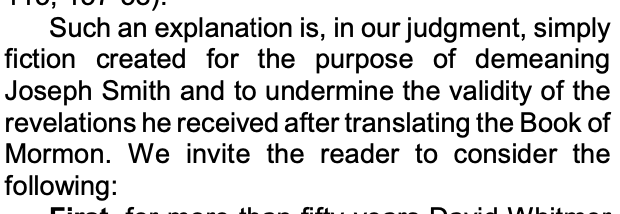

Now we see why Jim obstructed and obscured the hyperlink to McConkie's essay which contains the above statement that aligns with my CES Letter statement. It directly debunks Jim's above bullshit claims here that I'm misrepresenting Joseph Fielding McConkie and that I'm making things up.
It's right there in McConkie's own essay that Jim doesn't clearly hyperlink for his readers. It's deceptive and dishonest shit like this - pervasive all over Jim's dishonest document - that is specifically designed and engineered to smear and defame me and my integrity to his readers.

Guess who Joseph Fielding McConkie's father and grandfather were? Joseph Fielding Smith (tenth prophet) and Bruce R. McConkie (hardline apostle). Here's some goodies from these two men on seer stones:

Click graphic for more info

Moving on...after Jim deceives his readers by giving them the false impression that I misrepresented and mischaracterized McConkie - when it's actually Jim who is doing the misrepresenting and mischaracterizing - Jim then has the audacity to begin lecturing me with advice that he should be following himself.
Jim then creates the strawman and mischaracterization that I "aSsUmE mAliCiOuS iNtEnT" every chance I get and that I don't extend "charity" to explain "missteps" and problems with the Church and its history. I've seen this before and I've already responded to Jim's problematic "charitably interpret" approach to the Church's problems:
A key foundational pillar of Jim Bennett Mormonism® is, as Jim states:
"I think so many of our challenges and problems with the Church go away if we can charitably interpret the actions of leaders of the Church...who are just men...who are doing the best they can."
Once you understand this, you understand Jim's approach to the CES Letter and his methodology and strategy in dealing with the LDS Church's truth crisis.
Let's take this Jim Bennett Mormonism® idea for a test run:
Well...that test run didn't go so well.
The problem with Jim's "charity" and "generous interpretation" is that Jim overuses it and very liberally dispenses of it to the point of effectively destroying any litmus test for fraud. There is nothing that his religion and its leaders can do, with the exception of further mistreating the LGBTQ+ (Jim almost left the Church in 2015 over its November Policy), that will trigger Jim's litmus test alarm.
As we saw in the above video, Jim was very charitable toward his LDS leaders to the point where he boldly declared that no one was deliberately dishonest or deceptive. When John debunked Jim's unsupported claim and assertion by pointing to Joseph Fielding Smith ripping out and hiding the 1832 First Vision account, Jim's reaction wasn't that of introspection of his position and its weaknesses but rather an automatic "I want to be charitable to Joseph Fielding Smith."
With the Book of Abraham, Jim acknowledges that it's very problematic but rather than allow this problem to raise the red flag on Joseph Smith, Jim showers Joseph Smith with "charity" by clinging onto unsupported, unsustainable and absurd apologetics.
Ditto with the serious problems of Joseph Smith's polygamy and polyandry.
So, it's important to understand Jim's worldview and how he operates in relation to the Church, its leaders and its history to understand why he is constantly turning off alarm bells that otherwise would activate another's litmus test for fraud or raise red flags.
Late US Senator Robert Bennett's BOM Sermon
BONUS SECTION: A FINAL B of M SERMON
I would hope, at this point, that it’s obvious to readers that you haven’t managed to lay a glove on the Book of Mormon. You have provided several meager, contradictory, poorly- researched and easily-debunked explanations for its origins; you have completely ignored the significant external and internal evidence as to its authenticity, and you have tried to dismiss it entirely based solely on the weirdness of a rock in a hat. And, of course, your arguments pale in comparison to the nearly two centuries of assaults that book has endured from all sides.
And yet, the Book of Mormon still stands. Why is that?
I’ll answer by way of a story and a sermon.
In early 2015, my father, former Utah Senator Robert F. Bennett, discovered that he had pancreatic cancer.
Prior to his diagnosis, Dad had planned to move from his townhouse in Arlington, Virginia to his his childhood home in Salt Lake City, which he had purchased more than a decade earlier with the intent of living in Salt Lake City full time. But the cancer changed his plans, and he decided to seek treatment at John Hopkins University Hospital, which had a global reputation for being the best place to receive treatment for pancreatic cancer. The cancer had not spread, but the tumor was impinging on an artery, which made it impossible to remove. The goal, then, was to shrink the tumor by means of chemotherapy and then, by means of surgery, slice it out of his body.
It seemed a good plan at the time, but the tumor remained stubborn, and, while the chemo kept it from growing, it wasn’t shrinking, either. The goal shifted. The new plan was to kill the tumor and just leave it there. After another round of chemo and a new round of radiation, this was the presumed outcome. Dad came back to Utah for Christmas, and all seemed to be well. He had survived for a year after his diagnosis, and the idea that he had more years to come seemed like a real possibility.
Alas, no. The last day of February, 2016, we learned that the cancer had spread, and spread aggressively. He had only a few months left to live. Maybe weeks. It was time to get his affairs in order.
Since leaving the Senate, Dad had been extraordinarily active, and he had no interest in slowing down. Cancer had caused him to streamline his activities - he resigned from all the corporate boards that he said he “didn’t want to be on anyway” - but he still wasn’t willing to retire. He only focused on the things that truly mattered to him.
Learning that his days were definitely numbered, even more things fell by the wayside. There were only a handful of projects that remained a high priority, and his scheduled April 10, 2016 fireside on the Book of Mormon was at the top of his list.
It was back in 2009, that Deseret Book published Leap of Faith: Confronting the Origins of the Book of Mormon, a book Dad had been working on for the better part of seven years. Its release raised the eyebrows of a number of political pundits who thought it nothing more than a campaign gimmick, as Dad, at the time, was engaged in a very tough race that he eventually lost. But time has been quite kind to the book, and many now recognize it as a sober and valuable work.
“In my own turn, to be perfectly candid, when I first heard that Bennett had written such a manuscript, I doubted that it would be of much value,” wrote your favorite professor Daniel Peterson. “He was, after all, not a specialist, and I was certain that a busy senator had little time to keep up with the explosion of scholarship on the Book of Mormon that has occurred over the past several decades. What, beyond a shallow rehash, could it possibly offer?
“The answer, I quickly found out, was plenty. ‘Leap of Faith’ ... is a surprisingly good book.” He also said that “[i]t was plainly the product of sustained, careful reflection, not a hasty political ploy.”
President Henry B. Eyring went even further. As the concluding speaker at my father’s funeral in Salt Lake City, President Eyring called Dad’s book “possibly the best defense of the Book of Mormon ever written.” (I think that would make a pretty good blurb on the back of the paperback edition.)
Dad had long been passionate advocate of the Book of Mormon, and he was frustrated with this who refused to take it seriously. Indeed, the catalyst for writing “Leap of Faith” was the book “Mormon America” by Richard and Joan K. Ostling, which essentially dismissed the book as an obvious 19th Century invention and not an ancient record, siding with those who “assume that Joseph Smith wrote it” and that its origins have a “commonsense, naturalistic explanation.” From Dad’s point of view, the Book of Mormon was divinely designed to defy such easy and intellectually lazy dismissals, and he felt it necessary to demonstrate that faith in the Book of Mormon and reason-based arguments in favor of its historicity were not mutually exclusive. This idea animated him even into the waning hours of his life.
The assignment to give a fireside on the subject of the Book of Mormon came from the bishop of the Arlington Ward, and Dad saw this as more than just another speaking opportunity. He felt this was a calling from God, and he prepared accordingly. When he was told the cancer had spread, he almost immediately said, “I’ve got to stay alive for the fireside.” He repeated this over and over again, and the mantra worked. On the night of April 10, 2016, my father sat on a stool in the Arlington Chapel’s cultural hall and delivered a 50- minute sermon on the Book of Mormon. Weakened by cancer, he stayed seated much of the time, but he repeatedly stood to write on a blackboard, diagramming much of the book’s complexity for the gathered congregation. He spoke, as was his custom, without ever referring to notes. He spoke clearly and forcefully, and all who attended knew they were seeing something remarkable. (You can listen to a rough recording of the fireside and read a transcript here.)
That was Sunday. And on Monday morning, he suffered a severe stroke that left him paralyzed and confined to a hospital bed. He died three weeks later.
To his family, this seemed clear evidence that the Lord was sustaining my father specifically to share this one, simple message. After the fireside, Dad’s work was done, and he was called home. So whatever this message was seemed likely to be a pretty big deal.

Pictured: Bob Bennett with Sam Bennett on shoulders, Jim Bennett with Jeddy B. on shoulders. I miss this man every day.
So what was the message for which the Lord kept him alive to deliver?
“Well, the time is gone,” he said about forty-five minutes into his presentation, “but I need to end with the main point.” He recognized this was an odd way to structure a sermon. “You say, ‘Gee, you’ve been rambling for forty-five minutes. Get to the main point.’”
Prior to the “main point,” Dad had spent all his time recounting the various compelling evidences for the Book of Mormon’s authenticity. He cited the existence of Nahom and plethora of metal plates that prove that writing sacred records on plates and burying them for future generations was a practice rooted in antiquity. He also highlighted the use of ancient Egyptian names in the Book of Mormon that were unknown at the time of the book’s publication.
“All of this is interesting,” he said, “and it’s fun, and it’s important for us to know as we get attacked by those who are leaving the Church by telling Joseph Smith was a fraud, the Book of Mormon is a forgery, and so on – important for us to have the tools [to address these issues.]” But he insisted that “it’s not the main point.”
“You don’t need to know about the location of Nahom,” he said. “You don’t need to know about the proliferation of plates. You don’t need to understand about ancient names in order to live a more successful and worthwhile life.” Had he thought about it, he could have also said that you don’t need to know about the rock in the hat.
So what is it you need to know? Dad’s answer was simple:
“You need to know about the Lord Jesus Christ.”
He recounted an experience from his mission in Scotland more than sixty years earlier, in which he met Bill and Marian Proctor. “When we called on Bill and Marian Proctor for the first meeting, we had left a Book of Mormon with Marian,” he said. “We had gone tracting that morning, came back that night. He was reading it – Bill Proctor was reading the book by the fire, which I took as a good sign. And then he stood up and came to me, and he said, ‘Look, lads, I know why you’re here, and you’re wasting your time. I have no intention of joining your church. But this is an interesting book you have. So I’ll tell you what let’s do. I’ll buy your book, and you go on your way, and we’ll both save time. Agreed?’
“I said, ‘Agreed. Yep. But as long as we’re here...’
“Okay, so as long as we’re here, we sat down, and we gave them the first discussion of the Book of Mormon. And then we asked the magic question – when would be a good time for us to come back? And he gave us an appointment back, and there’s much more to the story, but very powerfully, before I left Scotland...”
Then Dad started to tear up. “Excuse me,” he said. “I get dewy-eyed at the dedication of a parking lot.”
After regaining his composure, he continued. “Before I left Scotland, I said to him, ‘When did you know? Bill, when did it happen [that you knew] the Book of Mormon was true?’ And he said, ‘Oh, that first night.’ He said, ‘The Spirit was there overwhelmingly, telling me it was true.’”
Bill Proctor “didn’t need any internal or external validations, or any intellectual analysis. All he needed was an open heart and the presence of the Holy Ghost, and he knew. The Book of Mormon can survive any attack by any enemy of the Church because the Proctor example has been repeated millions of times, in every culture, in every country, all around the world.”
Dad was absolutely right.
Jeremy's Response
My sincere condolences on the loss of your father, Jim. I can't imagine the loss of a beloved father and I can see the profound impact he has had on your life. He was a good man whose life philosophy of understanding and getting to know people before hating them allowed us to meet and become friends.
Out of respect for the late Senator, I'm going to leave this as-is and not take away from or distract from the Senator's words and work.
I'll respond to Jim's direct attacks on me elsewhere in the next section.
Jeremy doesn't lay a "glove" on BOM and book "still stands"
I would hope, at this point, that it’s obvious to readers that you haven’t managed to lay a glove on the Book of Mormon. You have provided several meager, contradictory, poorly- researched and easily-debunked explanations for its origins; you have completely ignored the significant external and internal evidence as to its authenticity, and you have tried to dismiss it entirely based solely on the weirdness of a rock in a hat. And, of course, your arguments pale in comparison to the nearly two centuries of assaults that book has endured from all sides.
And yet, the Book of Mormon still stands. Why is that?
Jeremy's Response

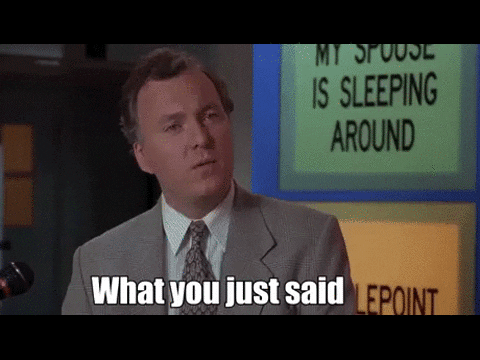
Let's break this up and unpack each attack individually:
"I would hope, at this point, that it’s obvious to readers that you haven’t managed to lay a glove on the Book of Mormon."
Jeremy's Response

"You have provided several meager, contradictory, poorly- researched and easily-debunked explanations for its origins"
Jeremy's Response
Elsewhere in this same chapter, you contradict yourself by claiming that I do not "provide any explanation" for the Book of Mormon and its existence and yet here you're saying that I do provide explanations for the Book of Mormon and its origins. Which is it?
This demonstrates that you just don't get it, Jim.
What you don't get, Jim, is that I wrote nothing in the CES Letter about the Book of Mormon's origin and how it was specifically authored, manufactured and created. Only you're doing that with your bullshit strawmen and misrepresentation of my statements.
All I've demonstrated is that the so-called "ancient" Book of Mormon contains fingerprints and signatures of modern / 19th-century works and influences that should not be present in the "ancient" book. It's anachronistic.
Even you admit that the Book of Mormon contains anachronisms:
Book of Mormon Anachronisms
I debunk your laughable and unsupported "meager, contradictory, poorly-researched and easily-debunked" attack in the Book of Mormon section.
Again, you just don't get it. Everything that I've pointed to is just demonstrating and conveying the same conclusions that Richard Bushman and other LDS scholars have also arrived at:

"The Book of Mormon is a problem right now. It’s so baffling to so many that Joseph was not even looking at the gold plates [to translate them]. And there’s so much in the Book of Mormon that comes out of the 19th century that there’s a question of whether or not the text is an exact transcription of Nephi’s and Mormon’s words, or if it has been reshaped by inspiration to be more suitable for us, a kind of an expansion or elucidation of the Nephite record for our times. I have no idea how that might have worked or whether that’s true. But there are just too many scholars now, faithful church scholars, who find 19th-century material in that text. That remains a little bit of a mystery, just how it came to be."
-Richard Bushman, December 31, 2020 Salt Lake Tribune interview
"Joseph Smith was very eclectic. He drew upon ideas from all over, including Masonic ritual."
-Richard Bushman, LDS scholar, Reddit Ask Me Anything, 12/06/13
All I'm pointing to in the CES Letter is the milieu of influences documented in Joseph Smith's time and place that are similar to the Book of Mormon's language, phrasing, theology, themes and claims.
It is only now in 2021 that I offer here for the first time what I consider to be the most plausible and natural secular hypothesis (since we'll never know for sure as its conspirators are all dead) on the Book of Mormon's authorship and origin. See The Lucy Code.
"you have completely ignored the significant external and internal evidence as to its authenticity"
Jeremy's Response
Go look at the Book of Mormon section to see the absurd and weak "significant" external and internal "evidences" that Jim thinks supports the Book of Mormon and its "authenticity". We do a line-by-line response and rebuttal to each one of Jim's "significant" external and internal "evidences".
I don't ignore these apologetic "evidences" for the Book of Mormon, Jim. I've written about and dissected them in my 2,000+ pages of Debunkings that you completely ignore and do not share with your readers. I'm not ignoring them...I've debunked them. The one here who is doing all the actual ignoring is you, Jim.
Just on anachronisms alone is sufficient enough to debunk something. If I were to show you this picture of Abraham Lincoln and claim that it's an untouched and accurate historical picture, would you believe me?

If you're a rational and sane person, you would clearly see that the above picture is fake. Why? Because it's an anachronism. It has an iPhone in Lincoln's hand that did not exist in the 1860s. I could offer you all kinds of gold medal gymnastic apologetics in the world trying to make this picture authentic and true and all you'd do is laugh at me. I could take a position like Jim does and try to tell you that this will become less anachronistic over time and you'd start to wonder about my mental health.
This is how scholars and academics who are experts in their specific fields look at the Book of Mormon and it's people like Jim who are trying to tell them that they need to take the picture (aka Book of Mormon) seriously while offering asinine apologetics that they think are "evidences" in attempts to legitimize the work.
Here's 2021 Jim Bennett when confronted on the Book of Mormon's anachronisms - which he admits are present in the book:
Book of Mormon Anachronisms
The one here who is ignoring the evidences and scholarship surrounding the Book of Mormon is Jim. In the above video, Jim is confronted by John about his opining and arriving at conclusions about the historicity of the Book of Mormon when he has not researched or considered what scholar, archaeologist and anthropologist Dr. Michael Coe of Yale has stated about the historicity of the Book of Mormon and what the fields of archaeology and anthropology have concluded about the Book of Mormon and claims of historicity surrounding it.
In the Testimony and Spiritual Witness section, Jim points to Hebraisms as one of his "significant evidences" for the Book of Mormon. Ironically, it's FairMormon who helps validate my point that Hebraisms are weak sauce because of 19th-century influence:
"The Book of Mormon does indeed have authentic Semitic constructions in it, but LDS need to tread cautiously in establishing them. Each must be evaluated on its own merits. Hebraisms that could have been known to Joseph Smith may still be authentic, and may still enhance our appreciation of the text, but they are weaker evidence for Book of Mormon antiquity since Joseph could have gotten them from his contemporary environment."
- FAIR, Hebraisms in the Book of Mormon
"you have tried to dismiss it entirely based solely on the weirdness of a rock in a hat."
Jeremy's Response
I'm trying to "dismiss it entirely based solely on the weirdness of a rock in hat"?

Why are you lying about me and misrepresenting my arguments, Jim? This is not my argument and position and I never claimed to be able to dismiss the Book of Mormon over the "weirdness" of the rock-in-the-hat let alone "entirely based solely" on the the weirdness of the rock-in-the-hat. All of this is just your bullshit strawman and misrepresentation.
As mentioned several times on this page, you just don't get the core problem of the rock-in-the-hat problem. You're stuck over there thinking I'm complaining because it's so weird and I'm mad that the leaders didn't put the rock-in-the-hat on every cover of the Ensign the last 40 years.
The rock-in-the-hat is much more than transparency problems (which is also a legitimate and major concern). The rock-in-the-hat opens up Pandora's Box to something deeply disturbing:
Mormonism was partially birthed out of and soaked in 19th-century rural New England folk magic and occultism and not primarily the Judeo-Christian / Biblical / Disneyfied Sunday School & Primary narrative, foundation and framework we had been led and indoctrinated to believe it being built upon.
"And yet, the Book of Mormon still stands. Why is that?"
Jeremy's Response
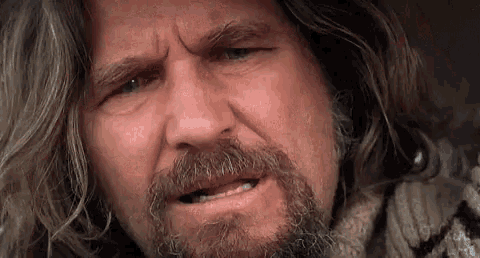
The Book of Mormon "still stands"? According to whom, Jim? You? Elder Holland? Believing Latter-day Saints?
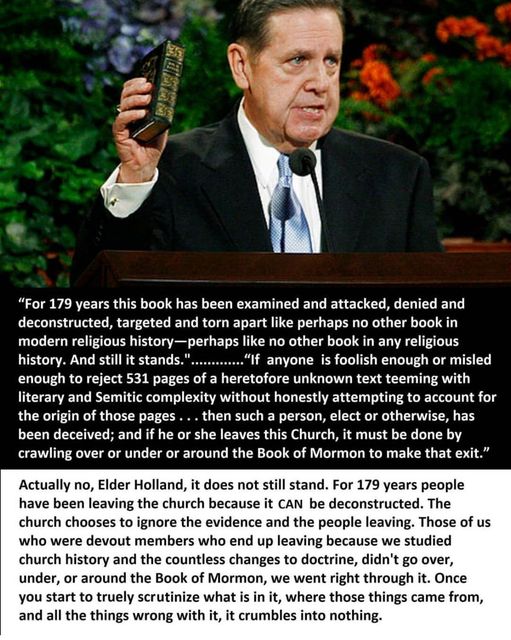
No one outside of Mormonism takes the book seriously. No one. It is either a laughingstock on Broadway or a big academic eyeroll:
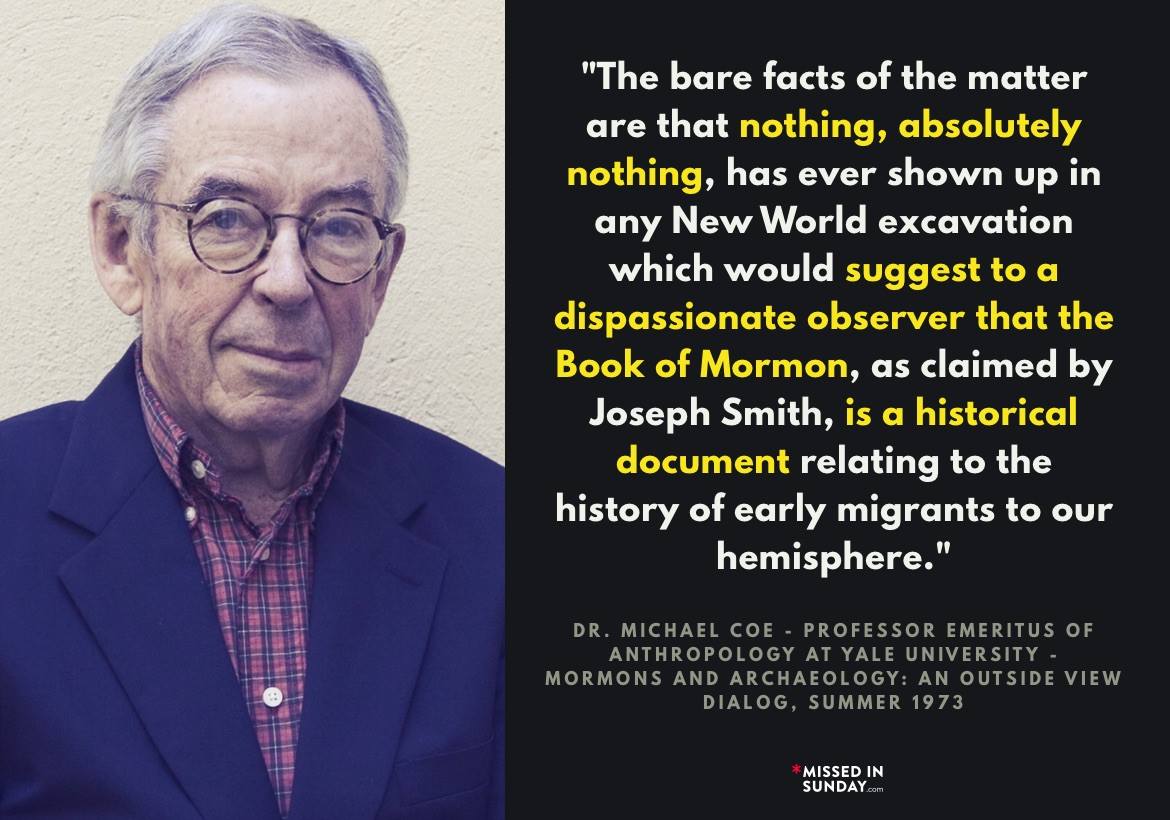
Click graphic for more info







